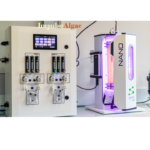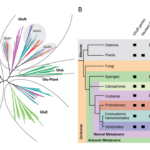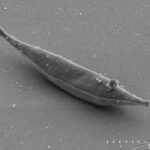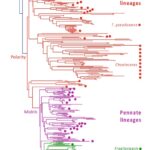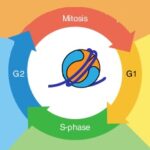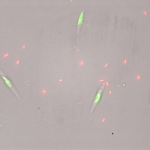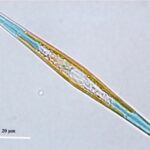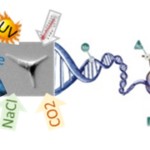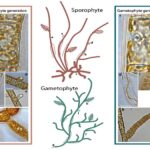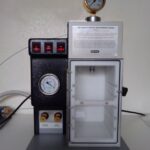Responsable : Leila TIRICHINE
Les microalgues sont à la base de la chaîne alimentaire de l’écosystème marin. Elles jouent un rôle primordial dans l’équilibre de notre planète grâce à leur fonction de photosynthèse qui fait d’elle le premier producteur d’oxygène et un véritable puits de carbone. Au-delà de leur importance écologique, elles représentent une source importante de composés bioactifs utilisés dans les industries pharmaceutiques, agroalimentaires, cosmétiques et de l’énergie.
Malgré leur importance écologique et économique, les bases moléculaires impliquées dans la réponse des microalgues à leur environnement et l’impact des changements que connaît notre planète sur leur devenir et évolution sont très peu connus. Nous étudions les mécanismes moléculaires en particulier épigénétiques, notamment la méthylation de l’ADN et les modifications post-traductionnelles des histones impliquées dans la réponse des micro-algues aux facteurs biotiques et abiotiques de l’environnement. Nous utilisons des approches multi-échelles, de la cellule entière/génome aux gènes, combinées à de la bioinformatique intégrative pour comprendre la biologie des modèles/systèmes étudiés en tant qu’entité et dans un contexte plus globale. Nous nous intéressons plus particulièrement à un groupe dominant des micro-algues, les diatomées et utilisons des espèces modèles ainsi que des approches moléculaires pluridisciplinaires pour comprendre comment les diatomées répondent aux contraintes biotiques et abiotiques des océans actuels. Nous utilisons des espèces modèles et non modèles pour étudier les interactions des diatomées avec les bactéries en particulier de type diazotrophe.
Mots-clés : bactéries, bioinformatique, diatomées, épigénétique, épigénomique, microalgues, microbiologie
Membres
Anciens membres de l'équipe
- Clément POULAIN, Stagiaire
- Maina BON, Stagiaire
- Udita CHANDOLA, Doctorante
- Timothée CHAUMIER, Ingénieur d'études
- Lucinda Duxbury, Stagiaire
- Marie ESNARD, Stagiaire
- Théo Ferré, Stagiaire
- Clara GUILLOUCHE, Stagiaire
- Antoine HOGUIN, Doctorant
- Louis-Josselin Lavier-Aydat, Assistant ingénieur
- EMIE LEFEVRE, Stagiaire
- Felipe Lopes Bacellar, Doctorant
- Louise MAHOUDEAU, Stagiaire
- Eric MANIRAKIZA, Ingénieur d'études
- Chaima NACIRI, Stagiaire
- Valentin PLANTIER, Stagiaire
- Corentin RAMAUGE-PARRA, Stagiaire
- Irene ROMERO RODRIGUEZ, Stagiaire
- Ellyn ROUSSELOT, Stagiaire
- Ellyn ROUSSELOT, Assistante ingénieure
- Nikunj SHARMA, Doctorant
- SHO SHIROMA, Stagiaire
- Katia TOUAHRI, Stagiaire
- Camille TROTTIER, Ingénieure d'études
- Léa VEILLARD , Stagiaire
- Yue WU, Doctorante
- Feng YANG, Doctorant
- Mhammad ZARIF, Doctorant
- Xue ZHAO, Doctorante
Projets
Anciens projets
Publications
5 publications
Rousselot, Ellyn; Nehr, Zofia; Aury, Jean-Marc; Denoeud, France; Cock, J Mark; Tirichine, Leïla; Duc, Céline
Identification of novel H2A histone variants across diverse clades of algae Article de journal À paraître
Dans: Genome Biology, À paraître.
@article{Rousselot2025,
title = {Identification of novel H2A histone variants across diverse clades of algae},
author = {Ellyn Rousselot and Zofia Nehr and Jean-Marc Aury and France Denoeud and J Mark Cock and Leïla Tirichine and Céline Duc},
editor = {Springer Nature},
year = {2025},
date = {2025-06-18},
urldate = {2025-06-18},
journal = {Genome Biology},
abstract = {Background
Histones are among the most conserved proteins in eukaryotes. They not only ensure DNA compaction in the nucleus but also participate in epigenetic regulation of gene expression. These key epigenetic players are divided into replication-coupled histones, expressed during the S-phase, and replication-independent variants, expressed throughout the cell cycle. Compared with other core histones, H2Aproteins exhibit a high level of variability but the characterization of algal H2A variants remains very limited.
Results
In this study, we exploit genome and transcriptome data from 22 species to identify H2A variants in brown seaweeds. Combined analyses of phylogenetic data, synteny and protein motifs enable us to reveal the presence of new H2A variants as well as their evolutionary history. We identify three new H2A variants: H2A.N, H2A.O and H2A.E. In brown seaweeds, the H2A.E and H2A.O variants arose from the same monophyletic clade while the H2A.N variant emerged independently. Moreover, the H2A.E variant seems to have a shared ancestry with RC H2A while the H2A.O variant has an H2A.X-characteristic signature without being orthologous to this variant. Based on mass spectrometry, we identify distinct epigenetic marks on these H2A variants. Finally, the H2A.Z, H2A.N and H2A.O from brown seaweeds are ubiquitously expressed while expression of H2A.E has tissue-specific patterns, especially in reproductive tissues.
Conclusions
We thus hypothesize that H2A.O and H2A.X might have convergent functions while H2A.E might fulfil some functions of replication-coupled H2As and/or compensate for the absence of repressive histone marks along with H2A.N.},
keywords = {},
pubstate = {forthcoming},
tppubtype = {article}
}
Histones are among the most conserved proteins in eukaryotes. They not only ensure DNA compaction in the nucleus but also participate in epigenetic regulation of gene expression. These key epigenetic players are divided into replication-coupled histones, expressed during the S-phase, and replication-independent variants, expressed throughout the cell cycle. Compared with other core histones, H2Aproteins exhibit a high level of variability but the characterization of algal H2A variants remains very limited.
Results
In this study, we exploit genome and transcriptome data from 22 species to identify H2A variants in brown seaweeds. Combined analyses of phylogenetic data, synteny and protein motifs enable us to reveal the presence of new H2A variants as well as their evolutionary history. We identify three new H2A variants: H2A.N, H2A.O and H2A.E. In brown seaweeds, the H2A.E and H2A.O variants arose from the same monophyletic clade while the H2A.N variant emerged independently. Moreover, the H2A.E variant seems to have a shared ancestry with RC H2A while the H2A.O variant has an H2A.X-characteristic signature without being orthologous to this variant. Based on mass spectrometry, we identify distinct epigenetic marks on these H2A variants. Finally, the H2A.Z, H2A.N and H2A.O from brown seaweeds are ubiquitously expressed while expression of H2A.E has tissue-specific patterns, especially in reproductive tissues.
Conclusions
We thus hypothesize that H2A.O and H2A.X might have convergent functions while H2A.E might fulfil some functions of replication-coupled H2As and/or compensate for the absence of repressive histone marks along with H2A.N.
Chandola, Udita; Gaudin, Marinna; Trottier, Camille; Lavier-Aydat, Louis-Josselin; Manirakiza, Eric; Menicot, Samuel; Fischer, Erik Jörg; Louvet, Isabelle; Lacour, Thomas; Chaumier, Timothée; Tanaka, Atsuko; Pohnert, Georg; Chaffron, Samuel; Tirichine, Leïla
Non-cyanobacterial diazotrophs support the survival of marine microalgae in nitrogen-depleted environment Article de journal
Dans: Genome Biology, 2025.
@article{nokey,
title = {Non-cyanobacterial diazotrophs support the survival of marine microalgae in nitrogen-depleted environment },
author = {Udita Chandola and Marinna Gaudin and Camille Trottier and Louis-Josselin Lavier-Aydat and Eric Manirakiza and Samuel Menicot and Erik Jörg Fischer and Isabelle Louvet and Thomas Lacour and Timothée Chaumier and Atsuko Tanaka and Georg Pohnert and Samuel Chaffron and Leïla Tirichine},
doi = {10.1186/s13059-025-03597-4},
year = {2025},
date = {2025-05-15},
urldate = {2025-05-15},
journal = {Genome Biology},
keywords = {},
pubstate = {published},
tppubtype = {article}
}
Téletchéa, Stéphane; an Johann Hendrickx, Bérangère Lombard; Loew, Damarys; Tirichine, Leïla
Glutamate Methylation, a Novel Histone Mark in Diatoms: Mass Spectrometry Identification and Structural Characterization Article de journal
Dans: Plant Direct, 2025.
@article{nokey,
title = {Glutamate Methylation, a Novel Histone Mark in Diatoms: Mass Spectrometry Identification and Structural Characterization},
author = {Stéphane Téletchéa and Bérangère Lombard an Johann Hendrickx and Damarys Loew and Leïla Tirichine},
doi = {10.1002/pld3.70051},
year = {2025},
date = {2025-05-13},
urldate = {2025-05-13},
journal = {Plant Direct},
keywords = {},
pubstate = {published},
tppubtype = {article}
}
Costanzo, Di; Marsico, F Di; Orefice, M; Kristoffersen, I; Kasapidis, JB; T, Chaumier; L, Ambrosino; M, Miralto; R, Aiese Cigliano; F, Verret; L, Tirichine; M, Trindade; L, Van Zyl; V, Di Dato; G, Romano
High-quality genome assembly and annotation of Thalassiosira rotula (synonym of Thalassiosira gravida) Article de journal
Dans: Sci Data, vol. 12, iss. 1, p. 310, 2025.
@article{nokey,
title = {High-quality genome assembly and annotation of Thalassiosira rotula (synonym of Thalassiosira gravida)},
author = {Di Costanzo and F Di Marsico and M Orefice and I Kristoffersen and JB Kasapidis and Chaumier T and Ambrosino L and Miralto M and Aiese Cigliano R and Verret F and Tirichine L and Trindade M and Van Zyl L and Di Dato V and Romano G},
doi = {10.1038/s41597-025-04634-4},
year = {2025},
date = {2025-02-20},
urldate = {2025-02-20},
journal = {Sci Data},
volume = {12},
issue = {1},
pages = {310},
abstract = {Diatoms are unicellular eukaryotic microorganisms thriving in most aquatic environments thanks to the expression of biosynthetic pathways for secondary metabolites involved in defence and adaptation to environmental changes. The sequencing of the transcriptome of the cosmopolitan diatom Thalassiosira rotula Meunier 1910 (synonym of Thalassiosira gravida Cleve 1896) and of the metagenome of its associated microbiome revealed the presence of biosynthetic pathways synthesising molecules and compounds useful for the algae survival and with potential biotechnological applications. Here we present the genome of a Neapolitan T. rotula strain, which is 672 Mbp in size due to a high proportion of repetitive elements (63.59%) and segmental duplications (14%), while the number of predicted genes resulted to be comparable to that of smaller diatom genomes. DNA methylation was predominantly located in transposable elements.},
keywords = {},
pubstate = {published},
tppubtype = {article}
}
Manirakiza, Eric; Chaumier, Timothée; Tirichine, Leila
Complete genome sequence of a marine Pseudoalteromonas bacterial strain Article de journal
Dans: Microbiol Resour Announc ., p. e0097524, 2025, ISBN: 39655917.
@article{nokey,
title = { Complete genome sequence of a marine Pseudoalteromonas bacterial strain},
author = {Eric Manirakiza and Timothée Chaumier and Leila Tirichine},
editor = {ASM Journals},
url = {https://journals.asm.org/doi/10.1128/mra.00975-24?url_ver=Z39.88-2003&rfr_id=ori:rid:crossref.org&rfr_dat=cr_pub%20%200pubmed},
doi = {10.1128/mra.00975-24},
isbn = {39655917},
year = {2025},
date = {2025-01-16},
urldate = {2025-01-16},
journal = {Microbiol Resour Announc .},
pages = {e0097524},
abstract = {Pseudoalteromonas is an abundant bacterial genera, found ubiquitously, including in extreme environments. Its broad metabolic capacity enables unique associations with various organisms. Using PacBio sequencing, we generated the complete genome sequence of a marine Pseudoalteromonas, revealing two circular chromosomes and one putative plasmid. The genome data are accessible at https://BacBrowse.univ-nantes.fr.},
keywords = {},
pubstate = {published},
tppubtype = {article}
}
5 publications
Maillard, Margaux; Stephant, Nicolas; Tanaka, Astsuko; Tirichine, Leila
Comprehensive protocol for preparing diatom cell samples and associated bacterial consortia for scanning electron microscopy Rapport technique
no. 103380, 2024.
@techreport{nokey,
title = {Comprehensive protocol for preparing diatom cell samples and associated bacterial consortia for scanning electron microscopy},
author = {Margaux Maillard and Nicolas Stephant and Astsuko Tanaka and Leila Tirichine},
editor = {Elsevier },
url = {https://www.sciencedirect.com/science/article/pii/S2666166724005458?via%3Dihub},
doi = {https://doi.org/10.1016/j.xpro.2024.103380},
year = {2024},
date = {2024-12-20},
urldate = {2024-12-20},
journal = {STAR Protocols},
volume = {5},
number = {103380},
issue = {4},
abstract = {Meticulous sample preparation and strict adherence to preservation procedures are essential for electron microscopy investigations, which enable accurate capture of organisms’ morphology, size, and potential interactions within the sample. Here, we present a protocol for preserving cells of the model diatom Phaeodactylum tricornutum and its native bacterial community. We describe steps for diatom fixation and coverslip preparation and washing. We then detail procedures for dehydrating, drying, and metallizing samples followed by observation using scanning electron microscopy.
},
keywords = {},
pubstate = {published},
tppubtype = {techreport}
}
Denoeud, France; Godfroy, Olivier; Cruaud, Corinne; Heesch, Svenja; Nehr, Zofia; Tadrent, Nachida; Couloux, Arnaud; Brillet-Guéguen, Loraine; Delage, Ludovic; Mckeown, Dean; Motomura, Taizo; Sussfeld, Duncan; 0and Lisa Mazéas, Xiao Fan; Terrapon, Nicolas; Barrera-Redondo, Josué; Petroll, Romy; Reynes, Lauric; Choi, Seok-Wan; Jo, Jihoon; Uthanumallian, Kavitha; Bogaert, Kenny; Duc, Céline; Ratchinski, Pélagie; Lipinska, Agnieszka; Noel, Benjamin; Murphy, Eleanor A; 0and Ananya Khatei, Martin Lohr; Hamon-Giraud, Pauline; Vieira, Christophe; Avia, Komlan; 0and Shingo Akita, Svea Sanja Akerfors; Badis, Yacine; Barbeyron, Tristan; Belcour, Arnaud; Berrabah, Wahiba; Blanquart, Samuel; Bouguerba-Collin, Ahlem; Bringloe, Trevor; Cattolico, Rose Ann; Cormier, Alexandre; de Carvalho, Helena Cruz; Dallet, Romain; Clerck, Olivier De; Debit, Ahmed; Denis, Erwan; Destombe, Christophe; Dinatale, Erica; Dittami, Simon; Drula, Elodie; 0and Jeanne Got, Sylvain Faugeron; Graf, Louis; Groisillier, Agnès; Guillemin, Marie-Laure; Harms, Lars; Hatchett, William John; Henrissat, Bernard; Hoarau, Galice; Jollivet, Chloé; Jueterbock, Alexander; Kayal, Ehsan; Knoll, Andrew H; Kogame, Kazuhiro; Bars, Arthur Le; Leblanc, Catherine; Gall, Line Le; 0and Xi Liu, Ronja Ley; LoDuca, Steven T; 0and Philippe Lopez, Pascal Jean Lopez; Manirakiza, Eric; Massau, Karine; Mauger, Stéphane; Mest, Laetitia; Michel, Gurvan; Monteiro, Catia; Nagasato, Chikako; Nègre, Delphine; Pelletier, Eric; Phillips, Naomi; Potin, Philippe; Rensing, Stefan A; Rousselot, Ellyn; Rousvoal, Sylvie; Schroeder, Declan; Scornet, Delphine; Siegel, Anne; Tirichine, Leila; Tonon, Thierry; Valentin, Klaus; Verbruggen, Heroen; Weinberger, Florian; Wheeler, Glen; Kawai, Hiroshi; Peters, Akira F; Yoon, Hwan Su; 0and Naihao Ye, Cécile Hervé; Bapteste, Eric; Valero, Myriam; Markov, Gabriel V; Corre, Erwan; Coelho, Susana M; Wincker, Patrick; Aury, Jean-Marc; Cock, J Mark
Evolutionary genomics of the emergence of brown algae as key components of coastal ecosystems Article de journal
Dans: Cell, vol. 187, iss. 24, p. 6943-6965, 2024.
@article{nokey,
title = {Evolutionary genomics of the emergence of brown algae as key components of coastal ecosystems},
author = {France Denoeud and Olivier Godfroy and Corinne Cruaud and Svenja Heesch and Zofia Nehr and Nachida Tadrent and Arnaud Couloux and Loraine Brillet-Guéguen and Ludovic Delage and Dean Mckeown and Taizo Motomura and Duncan Sussfeld and Xiao Fan 0and Lisa Mazéas and Nicolas Terrapon and Josué Barrera-Redondo and Romy Petroll and Lauric Reynes and Seok-Wan Choi and Jihoon Jo and Kavitha Uthanumallian and Kenny Bogaert and Céline Duc and Pélagie Ratchinski and Agnieszka Lipinska and Benjamin Noel and Eleanor A Murphy and Martin Lohr 0and Ananya Khatei and Pauline Hamon-Giraud and Christophe Vieira and Komlan Avia and Svea Sanja Akerfors 0and Shingo Akita and Yacine Badis and Tristan Barbeyron and Arnaud Belcour and Wahiba Berrabah and Samuel Blanquart and Ahlem Bouguerba-Collin and Trevor Bringloe and Rose Ann Cattolico and Alexandre Cormier and Helena Cruz de Carvalho and Romain Dallet and Olivier De Clerck and Ahmed Debit and Erwan Denis and Christophe Destombe and Erica Dinatale and Simon Dittami and Elodie Drula and Sylvain Faugeron 0and Jeanne Got and Louis Graf and Agnès Groisillier and Marie-Laure Guillemin and Lars Harms and William John Hatchett and Bernard Henrissat and Galice Hoarau and Chloé Jollivet and Alexander Jueterbock and Ehsan Kayal and Andrew H Knoll and Kazuhiro Kogame and Arthur Le Bars and Catherine Leblanc and Line Le Gall and Ronja Ley 0and Xi Liu and Steven T LoDuca and Pascal Jean Lopez 0and Philippe Lopez and Eric Manirakiza and Karine Massau and Stéphane Mauger and Laetitia Mest and Gurvan Michel and Catia Monteiro and Chikako Nagasato and Delphine Nègre and Eric Pelletier and Naomi Phillips and Philippe Potin and Stefan A Rensing and Ellyn Rousselot and Sylvie Rousvoal and Declan Schroeder and Delphine Scornet and Anne Siegel and Leila Tirichine and Thierry Tonon and Klaus Valentin and Heroen Verbruggen and Florian Weinberger and Glen Wheeler and Hiroshi Kawai and Akira F Peters and Hwan Su Yoon and Cécile Hervé 0and Naihao Ye and Eric Bapteste and Myriam Valero and Gabriel V Markov and Erwan Corre and Susana M Coelho and Patrick Wincker and Jean-Marc Aury and J Mark Cock },
editor = {Cell Press},
url = {https://www.cell.com/cell/fulltext/S0092-8674(24)01272-8?_returnURL=https%3A%2F%2Flinkinghub.elsevier.com%2Fretrieve%2Fpii%2FS0092867424012728%3Fshowall%3Dtrue},
doi = {doi: 10.1016/j.cell.2024.10.049},
year = {2024},
date = {2024-11-27},
journal = {Cell},
volume = {187},
issue = {24},
pages = {6943-6965},
abstract = {Brown seaweeds are keystone species of coastal ecosystems, often forming extensive underwater forests, and are under considerable threat from climate change. In this study, analysis of multiple genomes has provided insights across the entire evolutionary history of this lineage, from initial emergence, through later diversification of the brown algal orders, down to microevolutionary events at the genus level. Emergence of the brown algal lineage was associated with a marked gain of new orthologous gene families, enhanced protein domain rearrangement, increased horizontal gene transfer events, and the acquisition of novel signaling molecules and key metabolic pathways, the latter notably related to biosynthesis of the alginate-based extracellular matrix, and halogen and phlorotannin biosynthesis. We show that brown algal genome diversification is tightly linked to phenotypic divergence, including changes in life cycle strategy and zoid flagellar structure. The study also showed that integration of large viral genomes has had a significant impact on brown algal genome content throughout the emergence of the lineage.},
keywords = {},
pubstate = {published},
tppubtype = {article}
}
Manirakiza, Eric; Chaumier, Timothée; Tirichine, Leïla
Genomic sequences and annotations of two Pseudomonas species isolated from marine and terrestrial habitats Article de journal
Dans: Microbiol Resour Announc ., p. e0037324, 2024.
@article{nokey,
title = {Genomic sequences and annotations of two Pseudomonas species isolated from marine and terrestrial habitats},
author = {Eric Manirakiza and Timothée Chaumier and Leïla Tirichine},
editor = {ASM Journals},
doi = { https://doi.org/10.1128/mra.00373-24},
year = {2024},
date = {2024-08-27},
urldate = {2024-08-27},
journal = {Microbiol Resour Announc .},
pages = {e0037324},
abstract = {Here, we present the complete genome sequences and annotations of two species of the Pseudomonas genus isolated from marine and terrestrial environments. Both genomes and their annotations are available on BacBrowse (https://BacBrowse.univ-nantes.fr). This study will contribute to a better understanding of the diversity present within the Pseudomonas genus.},
keywords = {},
pubstate = {published},
tppubtype = {article}
}
Zarif, Mhammad; Rousselot, Ellyn; Jesus, Bruno; Tirichine, Leïla; Duc, Céline
H3K27me3 and EZH Are Involved in the Control of the Heat-Stress-Elicited Morphological Changes in Diatoms Article de journal
Dans: Int. J. Mol. Sci., vol. 25, iss. 15, p. 8373, 2024.
@article{nokey,
title = {H3K27me3 and EZH Are Involved in the Control of the Heat-Stress-Elicited Morphological Changes in Diatoms},
author = {Mhammad Zarif and Ellyn Rousselot and Bruno Jesus and Leïla Tirichine and Céline Duc},
editor = {MDPI},
url = {https://www.mdpi.com/1422-0067/25/15/8373},
doi = {doi.org/10.3390/ijms25158373},
year = {2024},
date = {2024-07-31},
journal = {Int. J. Mol. Sci.},
volume = {25},
issue = {15},
pages = {8373},
abstract = {Marine water temperatures are increasing due to anthropogenic climate change, constituting a major threat to marine ecosystems. Diatoms are major marine primary producers, and as such, they are subjected to marine heat waves and rising ocean temperatures. Additionally, under low tide, diatoms are regularly exposed to high temperatures. However, physiological and epigenetic responses to long-term exposure to heat stress remain largely unknown in the diatom Phaeodactylum tricornutum. In this study, we investigated changes in cell morphology, photosynthesis, and H3K27me3 abundance (an epigenetic mark consisting of the tri-methylation of lysine 27 on histone H3) after moderate and elevated heat stresses. Mutants impaired in PtEZH—the enzyme depositing H3K27me3—presented reduced growth and moderate changes in their PSII quantum capacities. We observed shape changes for the three morphotypes of P. tricornutum (fusiform, oval, and triradiate) in response to heat stress. These changes were found to be under the control of PtEZH. Additionally, both moderate and elevated heat stresses modulated the expression of genes encoding proteins involved in photosynthesis. Finally, heat stress elicited a reduction of genome-wide H3K27me3 levels in the various morphotypes. Hence, we provided direct evidence of epigenetic control of the H3K27me3 mark in the responses of Phaeodactylum tricornutum to heat stress.},
keywords = {},
pubstate = {published},
tppubtype = {article}
}
Timothée, Chaumier; Yang, Feng; Manirakiza, Eric; Ait-Mohamed, Ouardia; Wu, Yue; Chandola, Udita; Jesus, Bruno; Piganeau, Gwenael; Groisillier, Agnès; Tirichine, Leila
Genome-wide assessment of genetic diversity and transcript variations in 17 accessions of the model diatom Phaeodactylum tricornutum Article de journal
Dans: ISME Communications, vol. 4, iss. 1, p. ycad008, 2024.
@article{Timothée2024,
title = {Genome-wide assessment of genetic diversity and transcript variations in 17 accessions of the model diatom Phaeodactylum tricornutum},
author = {Chaumier Timothée and Feng Yang and Eric Manirakiza and Ouardia Ait-Mohamed and Yue Wu and Udita Chandola and Bruno Jesus and Gwenael Piganeau and Agnès Groisillier and Leila Tirichine},
url = {https://www.ncbi.nlm.nih.gov/pmc/articles/PMC10833087/},
doi = {10.1093/ismeco/ycad008},
year = {2024},
date = {2024-01-10},
urldate = {2024-01-10},
journal = {ISME Communications},
volume = {4},
issue = {1},
pages = {ycad008},
abstract = {Diatoms, a prominent group of phytoplankton, have a significant impact on both the oceanic food chain and carbon sequestration, thereby playing a crucial role in regulating the climate. These highly diverse organisms show a wide geographic distribution across various latitudes. In addition to their ecological significance, diatoms represent a vital source of bioactive compounds that are widely used in biotechnology applications. In the present study, we investigated the genetic and transcriptomic diversity of 17 accessions of the model diatom Phaeodactylum tricornutum including those sampled a century ago as well as more recently collected accessions. The analysis of the data reveals a higher genetic diversity and the emergence of novel clades, indicating an increasing diversity within the P. tricornutum population structure, compared to the previous study and a persistent long-term balancing selection of genes in old and newly sampled accessions. However, the study did not establish a clear link between the year of sampling and genetic diversity, thereby, rejecting the hypothesis of loss of heterozygoty in cultured strains. Transcript analysis identified novel transcript including noncoding RNA and other categories of small RNA such as PiwiRNAs. Additionally, transcripts analysis using differential expression as well as Weighted Gene Correlation Network Analysis has provided evidence that the suppression or downregulation of genes cannot be solely attributed to loss-of-function mutations. This implies that other contributing factors, such as epigenetic modifications, may play a crucial role in regulating gene expression. Our study provides novel genetic resources, which are now accessible through the platform PhaeoEpiview (https://PhaeoEpiView.univ-nantes.fr), that offer both ease of use and advanced tools to further investigate microalgae biology and ecology, consequently enriching our current understanding of these organisms.},
keywords = {},
pubstate = {published},
tppubtype = {article}
}
8 publications
Lin, Xin; Tirichine, Leïla; Zhang, Xu
The dynamic duo: how DNA methylation and gene transcription help diatoms thrive in modern oceans Article de journal
Dans: Journal of Experimental Botany, vol. 74, iss. 14, p. 3879–3882, 2023, ISSN: 00220957.
@article{Lin2023,
title = {The dynamic duo: how DNA methylation and gene transcription help diatoms thrive in modern oceans},
author = {Xin Lin and Leïla Tirichine and Xu Zhang},
url = {https://www.ncbi.nlm.nih.gov/pmc/articles/PMC10400112/
hal-04284583v1 },
doi = {10.1093/jxb/erad205},
issn = {00220957},
year = {2023},
date = {2023-08-03},
urldate = {2023-08-03},
journal = {Journal of Experimental Botany},
volume = {74},
issue = {14},
pages = {3879–3882},
abstract = {DNA methylation is essential for maintaining genome stability, mediating gene expression, and aiding species in adapting to their environment. Wan et al. (2023) measured the changes in phenotypic traits of the model diatom Phaeodactylum tricornutum in response to a 2-year exposure to ocean acidification, warming, or both, and analysed the concomitant changes in DNA methylation and transcriptomic patterns. Their study revealed that DNA methylation and gene transcription work in concert to enable unicellular phytoplankton to adapt to dynamic environmental changes.},
keywords = {},
pubstate = {published},
tppubtype = {article}
}
Hisanaga, Tetsuya; Romani, Facundo; Wu, Shuangyang; Kowar, Teresa; Wu, Yue; Lintermann, Ruth; Fridrich, Arie; Cho, Chung Hyun; Chaumier, Timothée; Jamge, Bhagyshree; Montgomery, Sean A; Axelsson, Elin; Akimcheva, Svetlana; Dierschke, Tom; Bowman, John L; Fujiwara, Takayuki; Hirooka, Shunsuke; Miyagishima, Shin-Ya; Dolan, Liam; Tirichine, Leila; Schubert, Daniel; Berger, Frédéric
The Polycomb repressive complex 2 deposits H3K27me3 and represses transposable elements in a broad range of eukaryotes Article de journal
Dans: Current Biology, vol. 33, iss. 20, p. 4367-4380.e9, 2023.
@article{Hisanaga2023,
title = {The Polycomb repressive complex 2 deposits H3K27me3 and represses transposable elements in a broad range of eukaryotes},
author = {Tetsuya Hisanaga and Facundo Romani and Shuangyang Wu and Teresa Kowar and Yue Wu and Ruth Lintermann and Arie Fridrich and Chung Hyun Cho and Timothée Chaumier and Bhagyshree Jamge and Sean A Montgomery and Elin Axelsson and Svetlana Akimcheva and Tom Dierschke and John L Bowman and Takayuki Fujiwara and Shunsuke Hirooka and Shin-Ya Miyagishima and Liam Dolan and Leila Tirichine and Daniel Schubert and Frédéric Berger},
url = {https://www.sciencedirect.com/science/article/pii/S0960982223011533?via%3Dihub
hal-04284522v1},
doi = {10.1016/j.cub.2023.08.073},
year = {2023},
date = {2023-08-02},
urldate = {2023-08-02},
journal = {Current Biology},
volume = {33},
issue = {20},
pages = {4367-4380.e9},
abstract = {The mobility of transposable elements (TEs) contributes to evolution of genomes. Their uncontrolled activity causes genomic instability; therefore, expression of TEs is silenced by host genomes. TEs are marked with DNA and H3K9 methylation, which are associated with silencing in flowering plants, animals, and fungi. However, in distantly related groups of eukaryotes, TEs are marked by H3K27me3 deposited by the Polycomb repressive complex 2 (PRC2), an epigenetic mark associated with gene silencing in flowering plants and animals. The direct silencing of TEs by PRC2 has so far only been shown in one species of ciliates. To test if PRC2 silences TEs in a broader range of eukaryotes, we generated mutants with reduced PRC2 activity and analyzed the role of PRC2 in extant species along the lineage of Archaeplastida and in the diatom P. tricornutum. In this diatom and the red alga C. merolae, a greater proportion of TEs than genes were repressed by PRC2, whereas a greater proportion of genes than TEs were repressed by PRC2 in bryophytes. In flowering plants, TEs contained potential cis-elements recognized by transcription factors and associated with neighbor genes as transcriptional units repressed by PRC2. Thus, silencing of TEs by PRC2 is observed not only in Archaeplastida but also in diatoms and ciliates, suggesting that PRC2 deposited H3K27me3 to silence TEs in the last common ancestor of eukaryotes. We hypothesize that during the evolution of Archaeplastida, TE fragments marked with H3K27me3 were selected to shape transcriptional regulation, controlling networks of genes regulated by PRC2.},
keywords = {},
pubstate = {published},
tppubtype = {article}
}
Wu, Yue; Tirichine, Leila
Chromosome-Wide Distribution and Characterization of H3K36me3 and H3K27Ac in the Marine Model Diatom Phaeodactylum tricornutum Article de journal
Dans: Plants (Basel), vol. 12, iss. 15, p. 2852, 2023.
@article{Wu2023b,
title = {Chromosome-Wide Distribution and Characterization of H3K36me3 and H3K27Ac in the Marine Model Diatom Phaeodactylum tricornutum},
author = {Yue Wu and Leila Tirichine },
url = {https://www.ncbi.nlm.nih.gov/pmc/articles/PMC10421102/
hal-04284555v1 },
doi = { 10.3390/plants12152852},
year = {2023},
date = {2023-08-02},
urldate = {2023-08-02},
journal = {Plants (Basel)},
volume = {12},
issue = {15},
pages = {2852},
keywords = {},
pubstate = {published},
tppubtype = {article}
}
Wu, Yue; Chaumier, Timothée; Manirakiza, Eric; Veluchamy, Alaguraj; Tirichine, Leila
PhaeoEpiView: an epigenome browser of the newly assembled genome of the model diatom Phaeodactylum tricornutum Article de journal
Dans: Scientific Reports , vol. 13, p. 8320, 2023, ISSN: 2045-2322.
@article{Wu2023,
title = {PhaeoEpiView: an epigenome browser of the newly assembled genome of the model diatom Phaeodactylum tricornutum},
author = {Yue Wu and Timothée Chaumier and Eric Manirakiza and Alaguraj Veluchamy and Leila Tirichine},
url = {https://www.ncbi.nlm.nih.gov/pmc/articles/PMC10206091/
hal-04284562v1 },
doi = { 10.1038/s41598-023-35403-1},
issn = {2045-2322},
year = {2023},
date = {2023-05-23},
urldate = {2023-05-23},
journal = {Scientific Reports },
volume = {13},
pages = {8320},
abstract = {Recent advances in DNA sequencing technologies particularly long-read sequencing, greatly improved genomes assembly. However, this has created discrepancies between published annotations and epigenome tracks, which have not been updated to keep pace with the new assemblies. Here, we used the latest improved telomere-to-telomere assembly of the model pennate diatom Phaeodactylum tricornutum to lift over the gene models from Phatr3, a previously annotated reference genome. We used the lifted genes annotation and newly published transposable elements to map the epigenome landscape, namely DNA methylation and post-translational modifications of histones. This provides the community with PhaeoEpiView, a browser that allows the visualization of epigenome data and transcripts on an updated and contiguous reference genome, to better understand the biological significance of the mapped data. We updated previously published histone marks with a more accurate peak calling using mono instead of poly(clonal) antibodies and deeper sequencing. PhaeoEpiView (https://PhaeoEpiView.univ-nantes.fr) will be continuously updated with the newly published epigenomic data, making it the largest and richest epigenome browser of any stramenopile. In the upcoming era of molecular environmental studies, where epigenetics plays a significant role, we anticipate that PhaeoEpiView will become a widely used tool.},
keywords = {},
pubstate = {published},
tppubtype = {article}
}
Hoguin, Antoine; Yang, Feng; Groisillier, Agnès; Bowler, Chris; Genovesio, Auguste; Ait-Mohamed, Ouardia; Vieira, Fabio Rocha Jimenez; Tirichine, Leila
The model diatom Phaeodactylum tricornutum provides insights into the diversity and function of microeukaryotic DNA methyltransferases Article de journal
Dans: Communications Biology, vol. 6, iss. 1, no. 1, p. 253, 2023, ISSN: 23993642.
@article{Hoguin2023,
title = {The model diatom Phaeodactylum tricornutum provides insights into the diversity and function of microeukaryotic DNA methyltransferases},
author = {Antoine Hoguin and Feng Yang and Agnès Groisillier and Chris Bowler and Auguste Genovesio and Ouardia Ait-Mohamed and Fabio Rocha Jimenez Vieira and Leila Tirichine},
editor = {Nature},
url = {https://www.ncbi.nlm.nih.gov/pmc/articles/PMC9998398/
hal-04024906v1 },
doi = {10.1038/s42003-023-04629-0 },
issn = {23993642},
year = {2023},
date = {2023-03-09},
urldate = {2023-03-09},
journal = {Communications Biology},
volume = {6},
number = {1},
issue = {1},
pages = {253},
abstract = {Cytosine methylation is an important epigenetic mark involved in the transcriptional control of transposable elements in mammals, plants and fungi. The Stramenopiles-Alveolate-Rhizaria (SAR) lineages are a major group of ecologically important marine microeukaryotes, including the phytoplankton groups diatoms and dinoflagellates. However, little is known about their DNA methyltransferase diversity. Here, we performed an in-silico analysis of DNA methyltransferases found in marine microeukaryotes and showed that they encode divergent DNMT3, DNMT4, DNMT5 and DNMT6 enzymes. Furthermore, we found three classes of enzymes within the DNMT5 family. Using a CRISPR/Cas9 strategy we demonstrated that the loss of the DNMT5a gene correlates with a global depletion of DNA methylation and overexpression of young transposable elements in the model diatom Phaeodactylum tricornutum. The study provides a view of the structure and function of a DNMT family in the SAR supergroup using an attractive model species.},
keywords = {},
pubstate = {published},
tppubtype = {article}
}
Tirichine, Leila; Piganeau, Gwenael
Editorial: Algal symbiotic relationships in freshwater and marine environments Article de journal
Dans: Front. Plant Sci., 2023.
@article{nokey,
title = {Editorial: Algal symbiotic relationships in freshwater and marine environments},
author = {Leila Tirichine and Gwenael Piganeau},
url = {https://www.frontiersin.org/articles/10.3389/fpls.2023.1155759/full
hal-04284580v1 },
doi = {doi: 10.3389/fpls.2023.1155759},
year = {2023},
date = {2023-02-20},
urldate = {2023-02-20},
journal = {Front. Plant Sci.},
keywords = {},
pubstate = {published},
tppubtype = {article}
}
Shao, Zhanru; andFabio Vieira, Osei Ampomah; Dorrell, Richard; Li, Shaoxuan; Tirichine, Leila; Bulone, Vincent; Duan, Delin; Bowler, Chris
Characterization of a Marine Diatom Chitin Synthase Using a Combination of Meta-Omics, Genomics, and Heterologous Expression Approaches. Article de journal
Dans: mSystems, 2023.
@article{nokey,
title = {Characterization of a Marine Diatom Chitin Synthase Using a Combination of Meta-Omics, Genomics, and Heterologous Expression Approaches. },
author = {Zhanru Shao and Osei Ampomah andFabio Vieira and Richard Dorrell and Shaoxuan Li and Leila Tirichine and Vincent Bulone and Delin Duan and Chris Bowler},
doi = {doi: 10.1128/msystems.01131-22},
year = {2023},
date = {2023-02-15},
urldate = {2023-02-15},
journal = {mSystems},
keywords = {},
pubstate = {published},
tppubtype = {article}
}
Poulet, Axel; Rousselot, Ellyn; Téletchéa, Stéphane; Noirot, Céline; Jacob, Yannick; Wolfswinkel, Josien; Thiriet, Christophe; Duc, Céline
The Histone Chaperone Network Is Highly Conserved in Physarum polycephalum Article de journal
Dans: International Journal of Molecular Sciences, vol. 24, no. 2, 2023, ISSN: 1422-0067.
@article{ijms24021051,
title = {The Histone Chaperone Network Is Highly Conserved in Physarum polycephalum},
author = {Axel Poulet and Ellyn Rousselot and Stéphane Téletchéa and Céline Noirot and Yannick Jacob and Josien Wolfswinkel and Christophe Thiriet and Céline Duc},
url = {https://www.mdpi.com/1422-0067/24/2/1051
hal-03978828v1 },
doi = {10.3390/ijms24021051},
issn = {1422-0067},
year = {2023},
date = {2023-01-01},
urldate = {2023-01-01},
journal = {International Journal of Molecular Sciences},
volume = {24},
number = {2},
abstract = {The nucleosome is composed of histones and DNA. Prior to their deposition on chromatin, histones are shielded by specialized and diverse proteins known as histone chaperones. They escort histones during their entire cellular life and ensure their proper incorporation in chromatin. Physarum polycephalum is a Mycetozoan, a clade located at the crown of the eukaryotic tree. We previously found that histones, which are highly conserved between plants and animals, are also highly conserved in Physarum. However, histone chaperones differ significantly between animal and plant kingdoms, and this thus probed us to further study the conservation of histone chaperones in Physarum and their evolution relative to animal and plants. Most of the known histone chaperones and their functional domains are conserved as well as key residues required for histone and chaperone interactions. Physarum is divergent from yeast, plants and animals, but PpHIRA, PpCABIN1 and PpSPT6 are similar in structure to plant orthologues. PpFACT is closely related to the yeast complex, and the Physarum genome encodes the animal-specific APFL chaperone. Furthermore, we performed RNA sequencing to monitor chaperone expression during the cell cycle and uncovered two distinct patterns during S-phase. In summary, our study demonstrates the conserved role of histone chaperones in handling histones in an early-branching eukaryote.},
keywords = {},
pubstate = {published},
tppubtype = {article}
}
7 publications
Chandola, Udita; Trottier, Camille; Gaudin, Marinna; Manirakiza, Erik; Menicot, Samuel; Louvet, Isabelle; Lacour, Thomas; Chaumier, Timothée; Tanaka, Atsuko; Chaffron, Samuel; Tirichine, Leila
Combined in vivo and in situ genome-resolved metagenomics reveals novel symbiotic nitrogen fixing interactions between non-cyanobacterial diazotrophs and microalgae Article de journal À paraître
Dans: bioRxiv, À paraître.
@article{Chandola2022.08.25.505241,
title = {Combined in vivo and in situ genome-resolved metagenomics reveals novel symbiotic nitrogen fixing interactions between non-cyanobacterial diazotrophs and microalgae},
author = {Udita Chandola and Camille Trottier and Marinna Gaudin and Erik Manirakiza and Samuel Menicot and Isabelle Louvet and Thomas Lacour and Timothée Chaumier and Atsuko Tanaka and Samuel Chaffron and Leila Tirichine},
url = {https://www.biorxiv.org/content/early/2022/08/25/2022.08.25.505241},
doi = {10.1101/2022.08.25.505241},
year = {2022},
date = {2022-08-25},
urldate = {2022-08-25},
journal = {bioRxiv},
publisher = {Cold Spring Harbor Laboratory},
abstract = {Non-cyanobacteria diazotrophs (NCDs) were shown to dominate in surface waters shifting the long-held paradigm of cyanobacteria dominance and raising fundamental questions on how these putative heterotrophic bacteria thrive in sunlit oceans. Here, we report an unprecedented finding in the widely used model diatom Phaeodactylum triconrnutum (Pt) of NCDs sustaining diatom cells in the absence of bioavailable nitrogen. We identified PtNCDs using metagenomics sequencing and detected nitrogenase gene in silico and/or by PCR. We demonstrated nitrogen fixation in PtNCDs and their close genetic affiliation with NCDs from the environment. We showed the wide occurrence of this type of symbiosis with the isolation of NCDs from other microalgae and their identification in the environment and in co-occurrence with photosynthetic microalgae. Overall, this study provides evidence for a previously overlooked symbiosis using a multidisciplinary model-based approach which will consequently help understand the different players driving global marine nitrogen fixation.Competing Interest StatementThe authors have declared no competing interest.},
keywords = {},
pubstate = {forthcoming},
tppubtype = {article}
}
Wu, Yue; Timothée, Chaumier; Manirakiza, Eric; Veluchamy, Alaguraj; Tirichine, Leila
PhaeoEpiView: An epigenome browser of the newly assembled genome of the model diatom Phaeodactylum tricornutum Article de journal À paraître
Dans: bioRxiv, À paraître.
@article{Wu2022.07.29.502047,
title = {PhaeoEpiView: An epigenome browser of the newly assembled genome of the model diatom Phaeodactylum tricornutum},
author = {Yue Wu and Chaumier Timothée and Eric Manirakiza and Alaguraj Veluchamy and Leila Tirichine},
url = {https://www.biorxiv.org/content/early/2022/08/01/2022.07.29.502047},
doi = {10.1101/2022.07.29.502047},
year = {2022},
date = {2022-08-01},
urldate = {2022-01-01},
journal = {bioRxiv},
publisher = {Cold Spring Harbor Laboratory},
abstract = {Motivation Recent advances in DNA sequencing technologies in particular of long reads type greatly improved genomes assembly leading to discrepancies between both published annotations and epigenome tracks which did not keep pace with new assemblies. This comprises the availability of accurate resources which penalizes the progress in research.Results Here, we used the latest improved telomere to telomere assembly of the model pennate diatom Phaeodactylum tricornutum to lift over the gene models from Phatr3, a previously annotated reference genome. We used the lifted genome annotation including genes and transposable elements to map the epigenome landscape, namely DNA methylation and post translational modifications of histones providing the community with PhaeoEpiView, a browser that allows the visualization of epigenome data as well as transcripts on an updated reference genome to better understand the biological significance of the mapped data on contiguous genome rather than a fragmented one. We updated previously published histone marks with a more accurate mapping using monoclonal antibodies instead of polyclonal and deeper sequencing. PhaeoEpiView will be continuously updated with the newly published epigenomic data making it the largest and richest epigenome browser of any stramenopile. We expect that PhaeoEpiView will be a standard tool for the coming era of molecular environmental studies where epigenetics holds a place of choice.Availability PhaeoEpiView is available at: https://PhaeoEpiView.univ-nantes.frCompeting Interest StatementThe authors have declared no competing interest.},
keywords = {},
pubstate = {forthcoming},
tppubtype = {article}
}
Sulser, Sandra; Vucicevic, Andrea; Bellini, Veronica; Moritz, Roxane; Delavat, François; Sentchilo, Vladimir; Carraro, Nicolas; van der Meer, Jan Roelof
A bistable prokaryotic differentiation system underlying development of conjugative transfer competence Article de journal
Dans: Plos Genetics, vol. 18, iss. 6, p. e1010286, 2022.
@article{doi.org/10.1371/journal.pgen.1010286,
title = {A bistable prokaryotic differentiation system underlying development of conjugative transfer competence},
author = {Sandra Sulser and Andrea Vucicevic and Veronica Bellini and Roxane Moritz and François Delavat and Vladimir Sentchilo and Nicolas Carraro and Jan Roelof van der Meer},
url = {hal-04202182v1 },
doi = {10.1371/journal.pgen.1010286},
year = {2022},
date = {2022-06-28},
urldate = {2022-06-28},
journal = {Plos Genetics},
volume = {18},
issue = {6},
pages = {e1010286},
abstract = {The mechanisms and impact of horizontal gene transfer processes to distribute gene functions with potential adaptive benefit among prokaryotes have been well documented. In contrast, little is known about the life-style of mobile elements mediating horizontal gene transfer, whereas this is the ultimate determinant for their transfer fitness. Here, we investigate the life-style of an integrative and conjugative element (ICE) within the genus Pseudomonas that is a model for a widespread family transmitting genes for xenobiotic compound metabolism and antibiotic resistances. Previous work showed bimodal ICE activation, but by using single cell time-lapse microscopy coupled to combinations of chromosomally integrated single copy ICE promoter-driven fluorescence reporters, RNA sequencing and mutant analysis, we now describe the complete regulon leading to the arisal of differentiated dedicated transfer competent cells. The regulon encompasses at least three regulatory nodes and five (possibly six) further conserved gene clusters on the ICE that all become expressed under stationary phase conditions. Time-lapse microscopy indicated expression of two regulatory nodes (i.e., bisR and alpA-bisDC) to precede that of the other clusters. Notably, expression of all clusters except of bisR was confined to the same cell subpopulation, and was dependent on the same key ICE regulatory factors. The ICE thus only transfers from a small fraction of cells in a population, with an estimated proportion of between 1.7-4%, which express various components of a dedicated transfer competence program imposed by the ICE, and form the centerpiece of ICE conjugation. The components mediating transfer competence are widely conserved, underscoring their selected fitness for efficient transfer of this class of mobile elements.},
keywords = {},
pubstate = {published},
tppubtype = {article}
}
Zhao, Xue; Hoguin, Antoine; Chaumier, Timothée; Tirichine, Leila
Epigenetic Control of Diatom Genomes: An Overview from In Silico Characterization to Functional Studies Chapitre d'ouvrage
Dans: Falciatore, Angela; Mock, Thomas (Ed.): The Molecular Life of Diatoms, p. 179–202, Springer International Publishing, Cham, 2022, ISBN: 978-3-030-92499-7.
@inbook{Zhao2022,
title = {Epigenetic Control of Diatom Genomes: An Overview from In Silico Characterization to Functional Studies},
author = {Xue Zhao and Antoine Hoguin and Timothée Chaumier and Leila Tirichine},
editor = {Angela Falciatore and Thomas Mock},
url = {https://doi.org/10.1007/978-3-030-92499-7_7},
doi = {10.1007/978-3-030-92499-7_7},
isbn = {978-3-030-92499-7},
year = {2022},
date = {2022-05-12},
urldate = {2022-01-01},
booktitle = {The Molecular Life of Diatoms},
pages = {179--202},
publisher = {Springer International Publishing},
address = {Cham},
abstract = {Epigenetics and its role in genome regulation is one of the most exciting areas of modern science. After a brief history of epigenetics and an introduction to the molecular basics of this discipline of science, this chapter describes the current knowledge of epigenetic components in diatoms, namely writers and erasers of DNA methylation and histone modifications. With a particular focus on the model pennate diatom Phaeodactylum tricornutum, we describe our current understanding of the contribution of few epigenetic factors to diatoms biology. Further, short regulatory non-coding RNAs (ncRNAs) as well as long ncRNAs are described in light of recent research. We highlight future studies and directions with a focus on epigenomic editing and environmental epigenetics.},
keywords = {},
pubstate = {published},
tppubtype = {inbook}
}
Sorée, Marion; Delavat, François; Lambert, Christophe; Lozach, Solen; Papin, Mathias; Petton, Bruno; Passerini, Delphine; Dégremont, Lionel; Heath, Dominique Hervio
Life history of oysters influences Vibrio parahaemolyticus accumulation in Pacific oysters (Crassostrea gigas ) Article de journal
Dans: Environmental Microbiology, p. 1462–2920.15996, 2022, ISSN: 1462-2912, 1462-2920.
@article{soree_life_2022,
title = {Life history of oysters influences Vibrio parahaemolyticus accumulation in Pacific oysters (Crassostrea gigas )},
author = {Marion Sorée and François Delavat and Christophe Lambert and Solen Lozach and Mathias Papin and Bruno Petton and Delphine Passerini and Lionel Dégremont and Dominique Hervio Heath},
url = {https://onlinelibrary.wiley.com/doi/10.1111/1462-2920.15996
hal-04202208v1 },
doi = {10.1111/1462-2920.15996},
issn = {1462-2912, 1462-2920},
year = {2022},
date = {2022-05-01},
urldate = {2022-05-01},
journal = {Environmental Microbiology},
pages = {1462--2920.15996},
abstract = {Vibrio parahaemolyticus infection in humans is asso- ciated with raw oyster consumption. Evaluation of V. parahaemolyticus presence in oysters is of most interest because of the economic and public health issues that it represents. To explore V. para- haemolyticus accumulation and depuration in adult Crassostrea gigas, we developed a GFP-tagged V. parahaemolyticus strain (IFVp201-gfp+), as well as a rapid and efficient quantification method in C. gigas oysters haemolymph by flow cytometry. Impact of the life history of C. gigas on accumulation and depuration of V. parahaemolyticus IFVp201 was sub- sequently investigated. We found that naive oysters, i.e. grown in controlled facilities with UV treated sea- water, accumulated significantly more IFVp201 than environmental oysters, i.e. grown in intertidal envi- ronment. We hypothesized that environmental oys- ters could have been immune primed, thus could limit V. parahaemolyticus accumulation. Meanwhile, both naive and environmental oysters had similardepuration rates.},
keywords = {},
pubstate = {published},
tppubtype = {article}
}
Bourdareau, Simon; Godfroy, Olivier; Gueno, Josselin; Scornet, Delphine; Coelho, Susana M.; Tirichine, Leila; Cock, Jean Mark
An Efficient Chromatin Immunoprecipitation Protocol for the Analysis of Histone Modification Distributions in the Brown Alga Ectocarpus Article de journal
Dans: Methods Protoc. , vol. 36, iss. 3, p. 36, 2022.
@article{nokey,
title = {An Efficient Chromatin Immunoprecipitation Protocol for the Analysis of Histone Modification Distributions in the Brown Alga Ectocarpus},
author = {Simon Bourdareau and Olivier Godfroy and Josselin Gueno and Delphine Scornet and Susana M. Coelho and Leila Tirichine and Jean Mark Cock},
url = {hal-03658367v1 },
doi = {doi: 10.3390/mps5030036},
year = {2022},
date = {2022-04-25},
urldate = {2022-04-25},
journal = {Methods Protoc. },
volume = {36},
issue = {3},
pages = {36},
keywords = {},
pubstate = {published},
tppubtype = {article}
}
Gueno, Josselin; Borg, Michael; Bourdareau, Simon; Cossard, Guillaume; Godfroy, Olivier; Lipinska, Agnieszka; Tirichine, Leila; Cock, J Mark; Coelho, Susana M
Chromatin landscape associated with sexual differentiation in a UV sex determination system Article de journal
Dans: Nucleic Acids Res, vol. 50, iss. 6, p. 3307-3322, 2022, ISSN: 1362-4962.
@article{pmid35253891,
title = {Chromatin landscape associated with sexual differentiation in a UV sex determination system},
author = {Josselin Gueno and Michael Borg and Simon Bourdareau and Guillaume Cossard and Olivier Godfroy and Agnieszka Lipinska and Leila Tirichine and J Mark Cock and Susana M Coelho},
doi = {doi: 10.1093/nar/gkac145},
issn = {1362-4962},
year = {2022},
date = {2022-03-01},
urldate = {2022-03-01},
journal = {Nucleic Acids Res},
volume = {50},
issue = {6},
pages = {3307-3322},
abstract = {In many eukaryotes, such as dioicous mosses and many algae, sex is determined by UV sex chromosomes and is expressed during the haploid phase of the life cycle. In these species, the male and female developmental programs are initiated by the presence of the U- or V-specific regions of the sex chromosomes but, as in XY and ZW systems, sexual differentiation is largely driven by autosomal sex-biased gene expression. The mechanisms underlying the regulation of sex-biased expression of genes during sexual differentiation remain elusive. Here, we investigated the extent and nature of epigenomic changes associated with UV sexual differentiation in the brown alga Ectocarpus, a model UV system. Six histone modifications were quantified in near-isogenic lines, leading to the identification of 16 chromatin signatures across the genome. Chromatin signatures correlated with levels of gene expression and histone PTMs changes in males versus females occurred preferentially at genes involved in sex-specific pathways. Despite the absence of chromosome scale dosage compensation and the fact that UV sex chromosomes recombine across most of their length, the chromatin landscape of these chromosomes was remarkably different to that of autosomes. Hotspots of evolutionary young genes in the pseudoautosomal regions appear to drive the exceptional chromatin features of UV sex chromosomes.},
keywords = {},
pubstate = {published},
tppubtype = {article}
}
10 publications
Bourdareau, Simon; Tirichine, Leila; Lombard, Bérangère; Loew, Damarys; Scornet, Delphine; Wu, Yue; Coelho, Susana M; Cock, Mark J
Histone modifications during the life cycle of the brown alga Ectocarpus Article de journal
Dans: Genome Biology, vol. 22, no. 1, 2021, ISSN: 1474760X.
@article{Bourdareau2021,
title = {Histone modifications during the life cycle of the brown alga Ectocarpus},
author = {Simon Bourdareau and Leila Tirichine and Bérangère Lombard and Damarys Loew and Delphine Scornet and Yue Wu and Susana M Coelho and Mark J Cock},
url = {https://pubmed.ncbi.nlm.nih.gov/33397407/},
doi = {10.1186/s13059-020-02216-8},
issn = {1474760X},
year = {2021},
date = {2021-12-01},
journal = {Genome Biology},
volume = {22},
number = {1},
publisher = {BioMed Central Ltd},
abstract = {Background: Brown algae evolved complex multicellularity independently of the animal and land plant lineages and are the third most developmentally complex phylogenetic group on the planet. An understanding of developmental processes in this group is expected to provide important insights into the evolutionary events necessary for the emergence of complex multicellularity. Here, we focus on mechanisms of epigenetic regulation involving post-translational modifications of histone proteins. Results: A total of 47 histone post-translational modifications are identified, including a novel mark H2AZR38me1, but Ectocarpus lacks both H3K27me3 and the major polycomb complexes. ChIP-seq identifies modifications associated with transcription start sites and gene bodies of active genes and with transposons. H3K79me2 exhibits an unusual pattern, often marking large genomic regions spanning several genes. Transcription start sites of closely spaced, divergently transcribed gene pairs share a common nucleosome-depleted region and exhibit shared histone modification peaks. Overall, patterns of histone modifications are stable through the life cycle. Analysis of histone modifications at generation-biased genes identifies a correlation between the presence of specific chromatin marks and the level of gene expression. Conclusions: The overview of histone post-translational modifications in the brown alga presented here will provide a foundation for future studies aimed at understanding the role of chromatin modifications in the regulation of brown algal genomes.},
keywords = {},
pubstate = {published},
tppubtype = {article}
}
Eisenhofer R Armbrecht L, Utge J
Paleo-diatom composition from Santa Barbara Basin deep-sea sediments: a comparison of 18S-V9 and diat-rbcL metabarcoding vs shotgun metagenomics. Article de journal
Dans: ISME Commun, 2021.
@article{nokey,
title = {Paleo-diatom composition from Santa Barbara Basin deep-sea sediments: a comparison of 18S-V9 and diat-rbcL metabarcoding vs shotgun metagenomics. },
author = {Armbrecht L, Eisenhofer R, Utge J, Sibert EC, Rocha F, Ward R, Pierella Karlusich JJ, Tirichine L, Norris R, Summers M, Bowler C},
doi = {doi: 10.1038/s43705-021-00070-8.},
year = {2021},
date = {2021-11-09},
urldate = {2021-11-09},
journal = {ISME Commun},
keywords = {},
pubstate = {published},
tppubtype = {article}
}
Morot, Amandine; Fekih, Sahar El; Bidault, Adeline; Ferrand, Alizée Le; Jouault, Albane; Kavousi, Javid; Bazire, Alexis; Pichereau, Vianney; Dufour, Alain; Paillard, Christine; Delavat, François
Virulence of Vibrio harveyi ORM4 toward the European abalone Haliotis tuberculata involves both quorum sensing and a type III secretion system Article de journal
Dans: Environmental Microbiology, vol. 23, no. 9, p. 5273-5288, 2021.
@article{https://doi.org/10.1111/1462-2920.15592,
title = {Virulence of Vibrio harveyi ORM4 toward the European abalone Haliotis tuberculata involves both quorum sensing and a type III secretion system},
author = {Amandine Morot and Sahar El Fekih and Adeline Bidault and Alizée Le Ferrand and Albane Jouault and Javid Kavousi and Alexis Bazire and Vianney Pichereau and Alain Dufour and Christine Paillard and François Delavat},
url = {https://sfamjournals.onlinelibrary.wiley.com/doi/abs/10.1111/1462-2920.15592
hal-04209594v1 },
doi = {https://doi.org/10.1111/1462-2920.15592},
year = {2021},
date = {2021-05-14},
urldate = {2021-05-14},
journal = {Environmental Microbiology},
volume = {23},
number = {9},
pages = {5273-5288},
abstract = {Abstract Environmental Vibrio strains represent a major threat in aquaculture, but the understanding of their virulence mechanisms heavily relies on the transposition of knowledge from human-pathogen vibrios. Here, the genetic bases of the virulence of Vibrio harveyi ORM4 toward the European abalone Haliotis tuberculata were characterized. We demonstrated that luxO, encoding a major regulator of the quorum sensing system, is crucial for the virulence of this strain, and that its deletion leads to a decrease in swimming motility, biofilm formation, and exopolysaccharide production. Furthermore, the biofilm formation by V. harveyi ORM4 was increased by abalone serum, which required LuxO. The absence of LuxO in V. harveyi ORM4 yielded opposite phenotypes compared with other Vibrio species including V. campbellii (still frequently named V. harveyi). In addition, we report a full Type III Secretion System (T3SS) gene cluster in the V. harveyi ORM4 genome. LuxO was shown to negatively regulate the promoter activity of exsA, encoding the major regulator of the T3SS genes, and the deletion of exsA abolished the virulence of V. harveyi ORM4. These results unveil virulence mechanisms set up by this environmentally important bacterial pathogen, and pave the way for a better molecular understanding of the regulation of its pathogenicity. This article is protected by copyright. All rights reserved.},
keywords = {},
pubstate = {published},
tppubtype = {article}
}
Zhao, Xue; Rastogi, Achal; Cabanillas, Anne Flore Deton; Mohamed, Ouardia Ait; Cantrel, Catherine; Lombard, Berangère; Murik, Omer; Genovesio, Auguste; Bowler, Chris; Bouyer, Daniel; Loew, Damarys; Lin, Xin; Veluchamy, Alaguraj; Vieira, Fabio Rocha Jimenez; Tirichine, Leila
Genome wide natural variation of H3K27me3 selectively marks genes predicted to be important for cell differentiation in Phaeodactylum tricornutum Article de journal
Dans: New Phytologist, p. nph.17129, 2021, ISSN: 0028-646X.
@article{Zhao2020b,
title = {Genome wide natural variation of H3K27me3 selectively marks genes predicted to be important for cell differentiation in Phaeodactylum tricornutum},
author = {Xue Zhao and Achal Rastogi and Anne Flore {Deton Cabanillas} and Ouardia {Ait Mohamed} and Catherine Cantrel and Berangère Lombard and Omer Murik and Auguste Genovesio and Chris Bowler and Daniel Bouyer and Damarys Loew and Xin Lin and Alaguraj Veluchamy and Fabio Rocha Jimenez Vieira and Leila Tirichine},
url = {https://onlinelibrary.wiley.com/doi/10.1111/nph.17129},
doi = {10.1111/nph.17129},
issn = {0028-646X},
year = {2021},
date = {2021-01-01},
urldate = {2020-12-01},
journal = {New Phytologist},
pages = {nph.17129},
publisher = {Blackwell Publishing Ltd},
abstract = {In multicellular organisms, Polycomb Repressive Complex2 (PRC2) is known to deposit tri-methylation of lysine 27 of histone H3 (H3K27me3) to establish and maintain gene silencing, critical for developmentally regulated processes. The PRC2 complex is absent in both widely studied model yeasts, which initially suggested that PRC2 arose with the emergence of multicellularity. However, its discovery in several unicellular species including microalgae questions its role in unicellular eukaryotes. Here, we use Phaeodactylum tricornutum enhancer of zeste E(z) knockouts and show that P. tricornutum E(z) is responsible for di- and tri-methylation of lysine 27 of histone H3. H3K27me3 depletion abolishes cell morphology in P. tricornutum providing evidence for its role in cell differentiation. Genome-wide profiling of H3K27me3 in fusiform and triradiate cells further revealed genes that may specify cell identity. These results suggest a role for PRC2 and its associated mark in cell differentiation in unicellular species, and highlight their ancestral function in a broader evolutionary context than currently is appreciated.},
keywords = {},
pubstate = {published},
tppubtype = {article}
}
Hoguin, Antoine; Rastogi, Achal; Bowler, Chris; Tirichine, Leila
Genome ‑ wide analysis of allele ‑ specific expression of genes in the model diatom Phaeodactylum tricornutum Article de journal
Dans: Scientific Reports, p. 1–10, 2021, ISSN: 2045-2322.
@article{Hoguin2021,
title = {Genome ‑ wide analysis of allele ‑ specific expression of genes in the model diatom Phaeodactylum tricornutum},
author = {Antoine Hoguin and Achal Rastogi and Chris Bowler and Leila Tirichine},
url = {https://doi.org/10.1038/s41598-021-82529-1},
doi = {10.1038/s41598-021-82529-1},
issn = {2045-2322},
year = {2021},
date = {2021-01-01},
journal = {Scientific Reports},
pages = {1--10},
publisher = {Nature Publishing Group UK},
abstract = {Recent advances in next generation sequencing technologies have allowed the discovery of widespread autosomal allele-specific expression (aASE) in mammals and plants with potential phenotypic effects. Extensive numbers of genes with allele-specific expression have been described in the diatom Fragilariopsis cylindrus in association with adaptation to external cues, as well as in Fistulifera solaris in the context of natural hybridization. However, the role of aASE and its extent in diatoms remain elusive. In this study, we investigate allele-specific expression in the model diatom Phaeodactylum tricornutum by the re-analysis of previously published whole genome RNA sequencing data and polymorphism calling. We found that 22% of P. tricornutum genes show moderate bias in allelic expression while 1% show nearly complete monoallelic expression. Biallelic expression associates with genes encoding components of protein metabolism while moderately biased genes associate with functions in catabolism and protein transport. We validated candidate genes by pyrosequencing and found that moderate biases in allelic expression were less stable than monoallelically expressed genes that showed consistent bias upon experimental validations at the population level and in subcloning experiments. Our approach provides the basis for the analysis of aASE in P. tricornutum and could be routinely implemented to test for variations in allele expression under different environmental conditions.},
keywords = {},
pubstate = {published},
tppubtype = {article}
}
Rahmani, Alexandra; Delavat, François; Lambert, Christophe; Goic, Nelly Le; Dabas, Eric; Paillard, Christine; Pichereau, Vianney
Dans: Frontiers in Cellular and Infection Microbiology, vol. 11, p. 634427, 2021, ISSN: 2235-2988.
@article{rahmani_implication_2021,
title = {Implication of the Type IV Secretion System in the Pathogenicity of Vibrio tapetis, the Etiological Agent of Brown Ring Disease Affecting the Manila Clam Ruditapes philippinarum},
author = {Alexandra Rahmani and François Delavat and Christophe Lambert and Nelly Le Goic and Eric Dabas and Christine Paillard and Vianney Pichereau},
url = {https://www.frontiersin.org/articles/10.3389/fcimb.2021.634427/full},
doi = {10.3389/fcimb.2021.634427},
issn = {2235-2988},
year = {2021},
date = {2021-01-01},
urldate = {2021-04-29},
journal = {Frontiers in Cellular and Infection Microbiology},
volume = {11},
pages = {634427},
abstract = {Vibrio tapetis is a Gram-negative bacterium that causes infections of mollusk bivalves and fish. The Brown Ring Disease (BRD) is an infection caused by V. tapetis that primarily affects the Manila clam Ruditapes philippinarum. Recent studies have shown that a type IV secretion system (T4SS) gene cluster is exclusively found in strains of V. tapetis pathogenic to clams. However, whether the T4SS is implicated or not during the infection process remains unknown. The aim of this study was to create and characterize a V. tapetis T4SS null mutant, obtained by a near-complete deletion of the virB4 gene, in order to determine the role of T4SS in the development of BRD. This study demonstrated that the T4SS is neither responsible for the loss of hemocyte adhesion capacities, nor for the decrease of the lysosomal activity during BRD. Nevertheless, we observed a 50% decrease of the BRD prevalence and a decrease of mortality dynamics with the DvirB4 mutant. This work demonstrates that the T4SS of V. tapetis plays an important role in the development of BRD in the Manila clam.},
keywords = {},
pubstate = {published},
tppubtype = {article}
}
Poulet, Axel; Mishra, Laxmi Narayan; Téletchéa, Stéphane; Hayes, Jeffrey J; Jacob, Yannick; Thiriet, Christophe; Duc, Céline
Identification and characterization of histones in Physarum polycephalum evidence a phylogenetic vicinity of Mycetozoans to the animal kingdom Article de journal
Dans: NAR Genomics and Bioinformatics, vol. 3, no. 4, 2021, ISSN: 2631-9268, (lqab107).
@article{10.1093/nargab/lqab107,
title = {Identification and characterization of histones in Physarum polycephalum evidence a phylogenetic vicinity of Mycetozoans to the animal kingdom},
author = {Axel Poulet and Laxmi Narayan Mishra and Stéphane Téletchéa and Jeffrey J Hayes and Yannick Jacob and Christophe Thiriet and Céline Duc},
url = {https://doi.org/10.1093/nargab/lqab107
hal-03595485v1 },
doi = {10.1093/nargab/lqab107},
issn = {2631-9268},
year = {2021},
date = {2021-01-01},
urldate = {2021-01-01},
journal = {NAR Genomics and Bioinformatics},
volume = {3},
number = {4},
abstract = {Physarum polycephalum belongs to Mycetozoans, a phylogenetic clade apart from the animal, plant and fungus kingdoms. Histones are nuclear proteins involved in genome organization and regulation and are among the most evolutionary conserved proteins within eukaryotes. Therefore, this raises the question of their conservation in Physarum and the position of this organism within the eukaryotic phylogenic tree based on histone sequences. We carried out a comprehensive study of histones in Physarum polycephalum using genomic, transcriptomic and molecular data. Our results allowed to identify the different isoforms of the core histones H2A, H2B, H3 and H4 which exhibit strong conservation of amino acid residues previously identified as subject to post-translational modifications. Furthermore, we also identified the linker histone H1, the most divergent histone, and characterized a large number of its PTMs by mass spectrometry. We also performed an in-depth investigation of histone genes and transcript structures. Histone proteins are highly conserved in Physarum and their characterization will contribute to a better understanding of the polyphyletic Mycetozoan group. Our data reinforce that P. polycephalum is evolutionary closer to animals than plants and located at the crown of the eukaryotic tree. Our study provides new insights in the evolutionary history of Physarum and eukaryote lineages.},
note = {lqab107},
keywords = {},
pubstate = {published},
tppubtype = {article}
}
Duc, Céline; Thiriet, Christophe
Replication-Coupled Chromatin Remodeling: An Overview of Disassembly and Assembly of Chromatin during Replication Article de journal
Dans: International Journal of Molecular Sciences, vol. 22, no. 3, 2021, ISSN: 1422-0067.
@article{ijms22031113,
title = {Replication-Coupled Chromatin Remodeling: An Overview of Disassembly and Assembly of Chromatin during Replication},
author = {Céline Duc and Christophe Thiriet},
url = {https://www.mdpi.com/1422-0067/22/3/1113
hal-04210949v1 },
doi = {10.3390/ijms22031113},
issn = {1422-0067},
year = {2021},
date = {2021-01-01},
urldate = {2021-01-01},
journal = {International Journal of Molecular Sciences},
volume = {22},
number = {3},
abstract = {The doubling of genomic DNA during the S-phase of the cell cycle involves the global remodeling of chromatin at replication forks. The present review focuses on the eviction of nucleosomes in front of the replication forks to facilitate the passage of replication machinery and the mechanism of replication-coupled chromatin assembly behind the replication forks. The recycling of parental histones as well as the nuclear import and the assembly of newly synthesized histones are also discussed with regard to the epigenetic inheritance.},
keywords = {},
pubstate = {published},
tppubtype = {article}
}
Hoguin, Antoine; Mohamed, Ouardia Ait; Bowler, Chris; Genovesio, Auguste; Vieira, Fabio Rocha Jimenez; Tirichine, Leila
Evolutionary analysis of DNA methyltransferases in microeukaryotes: Insights from the model diatom Phaeodactylum tricornutum Article de journal
Dans: bioRxiv, 2021.
@article{Hoguin2021.06.11.447926,
title = {Evolutionary analysis of DNA methyltransferases in microeukaryotes: Insights from the model diatom Phaeodactylum tricornutum},
author = {Antoine Hoguin and Ouardia Ait Mohamed and Chris Bowler and Auguste Genovesio and Fabio Rocha Jimenez Vieira and Leila Tirichine},
url = {https://www.biorxiv.org/content/early/2021/06/11/2021.06.11.447926},
doi = {10.1101/2021.06.11.447926},
year = {2021},
date = {2021-01-01},
urldate = {2021-01-01},
journal = {bioRxiv},
publisher = {Cold Spring Harbor Laboratory},
abstract = {Cytosine DNA methylation is an important epigenetic mark in eukaryotes that is involved in the transcriptional control of mainly transposable elements in mammals, plants, and fungi. Eukaryotes encode a diverse set of DNA methyltransferases that were iteratively acquired and lost during evolution. The Stramenopiles-Alveolate-Rhizaria (SAR) lineages are a major group of ecologically important marine microeukaryotes that include the main phytoplankton classes such as diatoms and dinoflagellates. However, little is known about the diversity of DNA methyltransferases and their role in the deposition and maintenance of DNA methylation in microalgae. We performed a phylogenetic analysis of DNA methyltransferase families found in marine microeukaryotes and show that they encode divergent DNMT3, DNMT4, DNMT5 and DNMT6 enzymes family revisiting previously established phylogenies. Furthermore, we reveal a novel group of DNMTs with three classes of enzymes within the DNMT5 family. Using a CRISPR/Cas9 strategy we demonstrate that the loss of the DNMT5 gene correlates with a global depletion of DNA methylation and overexpression of transposable elements in the model diatom Phaeodactylum tricornutum. The study provides a pioneering view of the structure and function of a DNMT family in the SAR supergroup.Competing Interest StatementThe authors have declared no competing interest.},
keywords = {},
pubstate = {published},
tppubtype = {article}
}
Armbrecht, Linda; Eisenhofer, Raphael; Utge, José; Sibert, Elizabeth C; Rocha, Fabio; Ward, Ryan; Karlusich, Juan José Pierella; Tirichine, Leila; Norris, Richard; Summers, Mindi; Bowler, Chris
Paleo-diatom composition from Santa Barbara Basin deep-sea sediments: a comparison of 18S-V9 and diat-rbcL metabarcoding vs shotgun metagenomics Article de journal
Dans: ISME Communications, vol. 1, no. 1, p. 1–10, 2021.
@article{armbrecht2021paleo,
title = {Paleo-diatom composition from Santa Barbara Basin deep-sea sediments: a comparison of 18S-V9 and diat-rbcL metabarcoding vs shotgun metagenomics},
author = {Linda Armbrecht and Raphael Eisenhofer and José Utge and Elizabeth C Sibert and Fabio Rocha and Ryan Ward and Juan José Pierella Karlusich and Leila Tirichine and Richard Norris and Mindi Summers and Chris Bowler},
year = {2021},
date = {2021-01-01},
urldate = {2021-01-01},
journal = {ISME Communications},
volume = {1},
number = {1},
pages = {1--10},
publisher = {Nature Publishing Group},
keywords = {},
pubstate = {published},
tppubtype = {article}
}
8 publications
Ait-Mohamed, Ouardia; Vanclová, Anna M G Novák; Joli, Nathalie; Liang, Yue; Zhao, Xue; Genovesio, Auguste; Tirichine, Leila; Bowler, Chris; Dorrell, Richard G
PhaeoNet: A Holistic RNAseq-Based Portrait of Transcriptional Coordination in the Model Diatom Phaeodactylum tricornutum Article de journal
Dans: Frontiers in Plant Science, vol. 11, 2020, ISSN: 1664462X.
@article{Ait-Mohamed2020,
title = {PhaeoNet: A Holistic RNAseq-Based Portrait of Transcriptional Coordination in the Model Diatom Phaeodactylum tricornutum},
author = {Ouardia Ait-Mohamed and Anna M G {Novák Vanclová} and Nathalie Joli and Yue Liang and Xue Zhao and Auguste Genovesio and Leila Tirichine and Chris Bowler and Richard G Dorrell},
url = {https://pubmed.ncbi.nlm.nih.gov/33178253/},
doi = {10.3389/fpls.2020.590949},
issn = {1664462X},
year = {2020},
date = {2020-10-01},
journal = {Frontiers in Plant Science},
volume = {11},
publisher = {Frontiers Media S.A.},
abstract = {Transcriptional coordination is a fundamental component of prokaryotic and eukaryotic cell biology, underpinning the cell cycle, physiological transitions, and facilitating holistic responses to environmental stress, but its overall dynamics in eukaryotic algae remain poorly understood. Better understanding of transcriptional partitioning may provide key insights into the primary metabolism pathways of eukaryotic algae, which frequently depend on intricate metabolic associations between the chloroplasts and mitochondria that are not found in plants. Here, we exploit 187 publically available RNAseq datasets generated under varying nitrogen, iron and phosphate growth conditions to understand the co-regulatory principles underpinning transcription in the model diatom Phaeodactylum tricornutum. Using WGCNA (Weighted Gene Correlation Network Analysis), we identify 28 merged modules of co-expressed genes in the P. tricornutum genome, which show high connectivity and correlate well with previous microarray-based surveys of gene co-regulation in this species. We use combined functional, subcellular localization and evolutionary annotations to reveal the fundamental principles underpinning the transcriptional co-regulation of genes implicated in P. tricornutum chloroplast and mitochondrial metabolism, as well as the functions of diverse transcription factors underpinning this co-regulation. The resource is publically available as PhaeoNet, an advanced tool to understand diatom gene co-regulation.},
keywords = {},
pubstate = {published},
tppubtype = {article}
}
Carraro, Nicolas; Richard, Xavier; Sulser, Sandra; Delavat, François; Mazza, Christian; van der Meer, Jan Roelof
An analog to digital converter controls bistable transfer competence development of a widespread bacterial integrative and conjugative element Article de journal
Dans: eLife, vol. 9, p. 1–40, 2020, ISSN: 2050084X.
@article{Carraro2020,
title = {An analog to digital converter controls bistable transfer competence development of a widespread bacterial integrative and conjugative element},
author = {Nicolas Carraro and Xavier Richard and Sandra Sulser and François Delavat and Christian Mazza and Jan Roelof van der Meer},
url = {hal-04202217v1 },
doi = {10.7554/eLife.57915},
issn = {2050084X},
year = {2020},
date = {2020-07-01},
urldate = {2020-07-01},
journal = {eLife},
volume = {9},
pages = {1--40},
publisher = {eLife Sciences Publications Ltd},
abstract = {Conjugative transfer of the integrative and conjugative element ICEclc in Pseudomonas requires development of a transfer competence state in stationary phase, which arises only in 3-5% of individual cells. The mechanisms controlling this bistable switch between non-active and transfer competent cells have long remained enigmatic. Using a variety of genetic tools and epistasis experiments in P. putida, we uncovered an ‘upstream' cascade of three consecutive transcription factor-nodes, which controls transfer competence initiation. One of the uncovered transcription factors (named BisR) is representative for a new regulator family. Initiation activates a feedback loop, controlled by a second hitherto unrecognized heteromeric transcription factor named BisDC. Stochastic modeling and experimental data demonstrated the feedback loop to act as a scalable converter of unimodal (population-wide or ‘analog') input to bistable (subpopulation-specific or ‘digital') output. The feedback loop further enables prolonged production of BisDC, which ensures expression of the ‘downstream' functions mediating ICE transfer competence in activated cells. Phylogenetic analyses showed that the ICEclc regulatory constellation with BisR and BisDC is widespread among Gamma-and Beta-proteobacteria, including various pathogenic strains, highlighting its evolutionary conservation and prime importance to control the behaviour of this wide family of conjugative elements.},
keywords = {},
pubstate = {published},
tppubtype = {article}
}
Zhao, Xue; Hoguin, Antoine; Chaumier, Timothée; Tirichine, Leila
Epigenetic control of diatom genomes: An overview from in Silico characterisation to functional studies Chapitre d'ouvrage
Dans: The molecular life of diatoms, Springer Nature Switzerland AG, 2020.
@inbook{cEQ5:ZHAO_TIRICHINE:2020,
title = {Epigenetic control of diatom genomes: An overview from in Silico characterisation to functional studies},
author = {Xue Zhao and Antoine Hoguin and Timothée Chaumier and Leila Tirichine},
year = {2020},
date = {2020-04-01},
booktitle = {The molecular life of diatoms},
publisher = {Springer Nature Switzerland AG},
keywords = {},
pubstate = {published},
tppubtype = {inbook}
}
Sato, Shinya; Nanjappa, Deepak; Dorrell, Richard G; Vieira, Fabio Rocha Jimenez; Kazamia, Elena; Tirichine, Leila; Veluchamy, Alaguraj; Heilig, Roland; Aury, Jean Marc; Jaillon, Olivier; Wincker, Patrick; Fussy, Zoltan; Obornik, Miroslav; Muñoz-Gómez, Sergio A; Mann, David G; Bowler, Chris; Zingone, Adriana
Dans: Scientific Reports, vol. 10, no. 1, p. 1–12, 2020, ISSN: 20452322.
@article{Sato2020,
title = {Genome-enabled phylogenetic and functional reconstruction of an araphid pennate diatom Plagiostriata sp. CCMP470, previously assigned as a radial centric diatom, and its bacterial commensal},
author = {Shinya Sato and Deepak Nanjappa and Richard G Dorrell and Fabio Rocha Jimenez Vieira and Elena Kazamia and Leila Tirichine and Alaguraj Veluchamy and Roland Heilig and Jean Marc Aury and Olivier Jaillon and Patrick Wincker and Zoltan Fussy and Miroslav Obornik and Sergio A Mu{ñ}oz-Gómez and David G Mann and Chris Bowler and Adriana Zingone},
doi = {10.1038/s41598-020-65941-x},
issn = {20452322},
year = {2020},
date = {2020-01-01},
journal = {Scientific Reports},
volume = {10},
number = {1},
pages = {1--12},
abstract = {Diatoms are an ecologically fundamental and highly diverse group of algae, dominating marine primary production in both open-water and coastal communities. The diatoms include both centric species, which may have radial or polar symmetry, and the pennates, which include raphid and araphid species and arose within the centric lineage. Here, we use combined microscopic and molecular information to reclassify a diatom strain CCMP470, previously annotated as a radial centric species related to Leptocylindrus danicus, as an araphid pennate species in the staurosiroid lineage, within the genus Plagiostriata. CCMP470 shares key ultrastructural features with Plagiostriata taxa, such as the presence of a sternum with parallel striae, and the presence of a highly reduced labiate process on its valve; and this evolutionary position is robustly supported by multigene phylogenetic analysis. We additionally present a draft genome of CCMP470, which is the first genome available for a staurosiroid lineage. 270 Pfams (19%) found in the CCMP470 genome are not known in other diatom genomes, which otherwise does not hold big novelties compared to genomes of non-staurosiroid diatoms. Notably, our DNA library contains the genome of a bacterium within the Rhodobacterales, an alpha-proteobacterial lineage known frequently to associate with algae. We demonstrate the presence of commensal alpha-proteobacterial sequences in other published algal genome and transcriptome datasets, which may indicate widespread and persistent co-occurrence.},
keywords = {},
pubstate = {published},
tppubtype = {article}
}
Rastogi, Achal; Vieira, Fabio Rocha Jimenez; Deton-Cabanillas, Anne-Flore; Veluchamy, Alaguraj; Cantrel, Catherine; Wang, Gaohong; Vanormelingen, Pieter; Bowler, Chris; Piganeau, Gwenael; Hu, Hanhua; Others,
A genomics approach reveals the global genetic polymorphism, structure, and functional diversity of ten accessions of the marine model diatom Phaeodactylum tricornutum Article de journal
Dans: The ISME journal, vol. 14, no. 2, p. 347–363, 2020.
@article{rastogi2020genomics,
title = {A genomics approach reveals the global genetic polymorphism, structure, and functional diversity of ten accessions of the marine model diatom Phaeodactylum tricornutum},
author = {Achal Rastogi and Fabio Rocha Jimenez Vieira and Anne-Flore Deton-Cabanillas and Alaguraj Veluchamy and Catherine Cantrel and Gaohong Wang and Pieter Vanormelingen and Chris Bowler and Gwenael Piganeau and Hanhua Hu and Others},
doi = {https://doi.org/10.1038/s41396-019-0528-3},
year = {2020},
date = {2020-01-01},
journal = {The ISME journal},
volume = {14},
number = {2},
pages = {347--363},
publisher = {Nature Publishing Group},
abstract = {Diatoms emerged in the Mesozoic period and presently constitute one of the main primary producers in the world's ocean and are of a major economic importance. In the current study, using whole genome sequencing of ten accessions of the model diatom Phaeodactylum tricornutum, sampled at broad geospatial and temporal scales, we draw a comprehensive landscape of the genomic diversity within the species. We describe strong genetic subdivisions of the accessions into four genetic clades (A–D) with constituent populations of each clade possessing a conserved genetic and functional makeup, likely a consequence of the limited dispersal of P. tricornutum in the open ocean. We further suggest dominance of asexual reproduction across all the populations, as implied by high linkage disequilibrium. Finally, we show limited yet compelling signatures of genetic and functional convergence inducing changes in the selection pressure on many genes and metabolic pathways. We propose these findings to have significant implications for understanding the genetic structure of diatom populations in nature and provide a framework to assess the genomic underpinnings of their ecological success and impact on aquatic ecosystems where they play a major role. Our work provides valuable resources for functional genomics and for exploiting the biotechnological potential of this model diatom species.},
keywords = {},
pubstate = {published},
tppubtype = {article}
}
Fan, Xiao; Han, Wentao; Teng, Linhong; Jiang, Peng; Zhang, Xiaowen; Xu, Dong; Li, Chang; Pellegrini, Matteo; Wu, Chunhui; Wang, Yitao; Kaczurowski, Michelle Joyce Slade; Lin, Xin; Tirichine, Leila; Mock, Thomas; Ye, Naihao
Single-base methylome profiling of the giant kelp Saccharina japonica reveals significant differences in DNA methylation to microalgae and plants Article de journal
Dans: New Phytologist, vol. 225, no. 1, p. 234–249, 2020, ISSN: 14698137.
@article{Fan2020,
title = {Single-base methylome profiling of the giant kelp Saccharina japonica reveals significant differences in DNA methylation to microalgae and plants},
author = {Xiao Fan and Wentao Han and Linhong Teng and Peng Jiang and Xiaowen Zhang and Dong Xu and Chang Li and Matteo Pellegrini and Chunhui Wu and Yitao Wang and Michelle Joyce Slade Kaczurowski and Xin Lin and Leila Tirichine and Thomas Mock and Naihao Ye},
doi = {10.1111/nph.16125},
issn = {14698137},
year = {2020},
date = {2020-01-01},
journal = {New Phytologist},
volume = {225},
number = {1},
pages = {234--249},
abstract = {Brown algae have convergently evolved plant-like body plans and reproductive cycles, which in plants are controlled by differential DNA methylation. This contribution provides the first single-base methylome profiles of haploid gametophytes and diploid sporophytes of a multicellular alga. Although only c. 1.4% of cytosines in Saccharina japonica were methylated mainly at CHH sites and characterized by 5-methylcytosine (5mC), there were significant differences between life-cycle stages. DNA methyltransferase 2 (DNMT2), known to efficiently catalyze tRNA methylation, is assumed to methylate the genome of S. japonica in the structural context of tRNAs as the genome does not encode any other DNA methyltransferases. Circular and long noncoding RNA genes were the most strongly methylated regulatory elements in S. japonica. Differential expression of genes was negatively correlated with DNA methylation with the highest methylation levels measured in both haploid gametophytes. Hypomethylated and highly expressed genes in diploid sporophytes included genes involved in morphogenesis and halogen metabolism. The data herein provide evidence that cytosine methylation, although occurring at a low level, is significantly contributing to the formation of different life-cycle stages, tissue differentiation and metabolism in brown algae.},
keywords = {},
pubstate = {published},
tppubtype = {article}
}
Zhao, Xue; Cabanillas, Anne Flore Deton; Veluchamy, Alaguraj; Bowler, Chris; Vieira, Fabio Rocha Jimenez; Tirichine, Leila
Probing the Diversity of Polycomb and Trithorax Proteins in Cultured and Environmentally Sampled Microalgae Article de journal
Dans: Frontiers in Marine Science, vol. 7, p. 189, 2020, ISSN: 2296-7745.
@article{10.3389/fmars.2020.00189,
title = {Probing the Diversity of Polycomb and Trithorax Proteins in Cultured and Environmentally Sampled Microalgae},
author = {Xue Zhao and Anne Flore {Deton Cabanillas} and Alaguraj Veluchamy and Chris Bowler and Fabio Rocha Jimenez Vieira and Leila Tirichine},
url = {https://www.frontiersin.org/article/10.3389/fmars.2020.00189},
doi = {10.3389/fmars.2020.00189},
issn = {2296-7745},
year = {2020},
date = {2020-01-01},
journal = {Frontiers in Marine Science},
volume = {7},
pages = {189},
abstract = {Polycomb (PcG) and Trithorax (TrxG) complexes are two evolutionarily conserved epigenetic regulatory components that act antagonistically to regulate the expression of genes involved in cell differentiation and development in multicellular organisms. The absence of PcG in both yeast models Saccharomyces cerevisiae and Schizosaccharomyces pombe suggested that polycomb proteins might have evolved together with the emergence of multicellular organisms. However, high throughput sequencing of several microalgal genomes and transcriptomes reveals an unprecedented abundance and diversity of genes encoding the components of these complexes. We report here the diversity of genes encoding PcG and TrxG proteins in microalgae from the Marine Microbial Eukaryote Transcriptome Sequencing Project database (MMETSP) and detected at broad scale in Tara Oceans genomics datasets using a highly sensitive method called eDAF (enhanced Domain Architecture Filtering). Further, we explored the correlation between environmental factors measured during the Tara Oceans expedition and transcript levels of PcG and TrxG components. PcG and TrxG are responsible for the deposition of a number of histone marks among which a TrxG associated mark, H3K4me3 which we profiled genome wide in the model diatom Phaeodactylum tricornutum to understand its role in microalgae and revisited the previously published histone code and co-occurrence with other histone marks including the antagonizing Polycomb deposited mark H3K27me3.},
keywords = {},
pubstate = {published},
tppubtype = {article}
}
Rathor, Pramod; Borza, Tudor; Liu, Yanhui; Qin, Yuan; Stone, Sophia; Zhang, Junzeng; Hui, Joseph P M; Berrue, Fabrice; Groisillier, Agnès; Tonon, Thierry; Yurgel, Svetlana; Potin, Philippe; Prithiviraj, Balakrishnan
Low Mannitol Concentrations in Arabidopsis thaliana Expressing Ectocarpus Genes Improve Salt Tolerance Article de journal
Dans: Plants, vol. 9, no. 11, 2020, ISSN: 2223-7747.
@article{plants9111508,
title = {Low Mannitol Concentrations in Arabidopsis thaliana Expressing Ectocarpus Genes Improve Salt Tolerance},
author = {Pramod Rathor and Tudor Borza and Yanhui Liu and Yuan Qin and Sophia Stone and Junzeng Zhang and Joseph P M Hui and Fabrice Berrue and Agnès Groisillier and Thierry Tonon and Svetlana Yurgel and Philippe Potin and Balakrishnan Prithiviraj},
url = {https://www.mdpi.com/2223-7747/9/11/1508},
doi = {10.3390/plants9111508},
issn = {2223-7747},
year = {2020},
date = {2020-01-01},
journal = {Plants},
volume = {9},
number = {11},
abstract = {Mannitol is abundant in a wide range of organisms, playing important roles in biotic and abiotic stress responses. Nonetheless, mannitol is not produced by a vast majority of plants, including many important crop plants. Mannitol-producing transgenic plants displayed improved tolerance to salt stresses though mannitol production was rather low, in the µM range, compared to mM range found in plants that innately produce mannitol. Little is known about the molecular mechanisms underlying salt tolerance triggered by low concentrations of mannitol. Reported here is the production of mannitol in Arabidopsis thaliana, by expressing two mannitol biosynthesis genes from the brown alga Ectocarpus sp. strain Ec32. To date, no brown algal genes have been successfully expressed in land plants. Expression of mannitol-1-phosphate dehydrogenase and mannitol-1-phosphatase genes was associated with the production of 42.3-52.7 nmol g−1 fresh weight of mannitol, which was sufficient to impart salinity and temperature stress tolerance. Transcriptomics revealed significant differences in the expression of numerous genes, in standard and salinity stress conditions, including genes involved in K+ homeostasis, ROS signaling, plant development, photosynthesis, ABA signaling and secondary metabolism. These results suggest that the improved tolerance to salinity stress observed in transgenic plants producing mannitol in µM range is achieved by the activation of a significant number of genes, many of which are involved in priming and modulating the expression of genes involved in a variety of functions including hormone signaling, osmotic and oxidative stress, and ion homeostasis.},
keywords = {},
pubstate = {published},
tppubtype = {article}
}
5 publications
Murik, Omer; Tirichine, Leila; Prihoda, Judit; Thomas, Yann; Araújo, Wagner L; Allen, Andrew E; Fernie, Alisdair R; Bowler, Chris
Downregulation of mitochondrial alternative oxidase affects chloroplast function, redox status and stress response in a marine diatom Article de journal
Dans: New Phytologist, vol. 221, no. 3, p. 1303–1316, 2019, ISSN: 14698137.
@article{Murik2019,
title = {Downregulation of mitochondrial alternative oxidase affects chloroplast function, redox status and stress response in a marine diatom},
author = {Omer Murik and Leila Tirichine and Judit Prihoda and Yann Thomas and Wagner L Ara{ú}jo and Andrew E Allen and Alisdair R Fernie and Chris Bowler},
doi = {10.1111/nph.15479},
issn = {14698137},
year = {2019},
date = {2019-01-01},
journal = {New Phytologist},
volume = {221},
number = {3},
pages = {1303--1316},
abstract = {Diatom dominance in contemporary aquatic environments indicates that they have developed unique and effective mechanisms to cope with the rapid and considerable fluctuations that characterize these environments. In view of their evolutionary history from a secondary endosymbiosis, inter-organellar regulation of biochemical activities may be of particular relevance. Diatom mitochondrial alternative oxidase (AOX) is believed to play a significant role in supplying chloroplasts with ATP produced in the mitochondria. Using the model diatom Phaeodactylum tricornutum we generated AOX knockdown lines, and followed sensitivity to stressors, photosynthesis and transcriptome and metabolome profiles of wild-type and knockdown lines. We show here that expression of the AOX gene is upregulated by various stresses including H 2 O 2 , heat, high light illumination, and iron or nitrogen limitation. AOX knockdown results in hypersensitivity to stress. Knockdown lines also show significantly reduced photosynthetic rates and their chloroplasts are more oxidized. Comparisons of transcriptome and metabolome profiles suggest a strong impact of AOX activity on gene expression, which is carried through to the level of the metabolome. Our data provide evidence for the involvement of mitochondrial AOX in processes central to the cell biology of diatoms, revealing that cross-talk between mitochondria and chloroplasts is crucial for maintaining sensitivity to changing environments.},
keywords = {},
pubstate = {published},
tppubtype = {article}
}
Huang, Ruiping; Ding, Jiancheng; Gao, Kunshan; de Carvalho, Maria Helena; Tirichine, Leila; Bowler, Chris; Lin, Xin
A Potential Role for Epigenetic Processes in the Acclimation Response to Elevated pCO2 in the Model Diatom Phaeodactylum tricornutum Article de journal
Dans: Frontiers in Microbiology, vol. 9, p. 3342, 2019, ISSN: 1664-302X.
@article{10.3389/fmicb.2018.03342,
title = {A Potential Role for Epigenetic Processes in the Acclimation Response to Elevated pCO2 in the Model Diatom Phaeodactylum tricornutum},
author = {Ruiping Huang and Jiancheng Ding and Kunshan Gao and Maria Helena de Carvalho and Leila Tirichine and Chris Bowler and Xin Lin},
url = {https://www.frontiersin.org/article/10.3389/fmicb.2018.03342},
doi = {10.3389/fmicb.2018.03342},
issn = {1664-302X},
year = {2019},
date = {2019-01-01},
journal = {Frontiers in Microbiology},
volume = {9},
pages = {3342},
abstract = {Understanding of the molecular responses underpinning diatom responses to ocean acidification is fundamental for predicting how important primary producers will be shaped by the continuous rise in atmospheric CO2. In this study, we have analyzed global transcriptomic changes of the model diatom Phaeodactylum tricornutum following growth for 15 generations in elevated pCO2 by strand-specific RNA sequencing (ssRNA-seq). Our results indicate that no significant effects of elevated pCO2 and associated carbonate chemistry changes on the physiological performance of the cells were observed after 15 generations whereas the expression of genes encoding histones and other genes involved in chromatin structure were significantly down-regulated, while the expression of transposable elements (TEs) and genes encoding histone acetylation enzymes were significantly up-regulated. Furthermore, we identified a series of long non-protein coding RNAs (lncRNAs) specifically responsive to elevated pCO2, suggesting putative regulatory roles for these largely uncharacterized genome components. Taken together, our integrative analyses reveal that epigenetic elements such as TEs, histone modifications and lncRNAs may have important roles in the acclimation of diatoms to elevated pCO2 over short time scales and thus may influence longer term adaptive processes in response to progressive ocean acidification.},
keywords = {},
pubstate = {published},
tppubtype = {article}
}
Shao, Zhanru; Thomas, Yann; Hembach, Lea; Xing, Xiaohui; Duan, Delin; Moerschbacher, Bruno M; Bulone, Vincent; Tirichine, Leila; Bowler, Chris
Dans: New Phytologist, vol. 221, no. 4, p. 1890–1905, 2019, ISSN: 14698137.
@article{Shao2019,
title = {Comparative characterization of putative chitin deacetylases from Phaeodactylum tricornutum and Thalassiosira pseudonana highlights the potential for distinct chitin-based metabolic processes in diatoms},
author = {Zhanru Shao and Yann Thomas and Lea Hembach and Xiaohui Xing and Delin Duan and Bruno M Moerschbacher and Vincent Bulone and Leila Tirichine and Chris Bowler},
doi = {10.1111/nph.15510},
issn = {14698137},
year = {2019},
date = {2019-01-01},
journal = {New Phytologist},
volume = {221},
number = {4},
pages = {1890--1905},
abstract = {Chitin is generally considered to be present in centric diatoms but not in pennate species. Many aspects of chitin biosynthetic pathways have not been explored in diatoms. We retrieved chitin metabolic genes from pennate (Phaeodactylum tricornutum) and centric (Thalassiosira pseudonana) diatom genomes. Chitin deacetylase (CDA) genes from each genome (PtCDA and TpCDA) were overexpressed in P. tricornutum. We performed comparative analysis of their sequence structure, phylogeny, transcriptional profiles, localization and enzymatic activities. The chitin relevant proteins show complex subcellular compartmentation. PtCDA was likely acquired by horizontal gene transfer from prokaryotes, whereas TpCDA has closer relationships with sequences in Opisthokonta. Using transgenic P. tricornutum lines expressing CDA-green fluorescent protein (GFP) fusion proteins, PtCDA predominantly localizes to Golgi apparatus whereas TpCDA localizes to endoplasmic reticulum/chloroplast endoplasmic reticulum membrane. CDA-GFP overexpression upregulated the transcription of chitin synthases and potentially enhanced the ability of chitin synthesis. Although both CDAs are active on GlcNAc 5 , TpCDA is more active on the highly acetylated chitin polymer DA60. We have addressed the ambiguous characters of CDAs from P. tricornutum and T. pseudonana. Differences in localization, evolution, expression and activities provide explanations underlying the greater potential of centric diatoms for chitin biosynthesis. This study paves the way for in vitro applications of novel CDAs.},
keywords = {},
pubstate = {published},
tppubtype = {article}
}
Caputi, L; Carradec, Q; Eveillard, D; Kirilovsky, A; Pelletier, E; Karlusich, J J Pierella; Vieira, F Rocha Jimenez; Villar, E; Chaffron, S; Malviya, S; Scalco, E; Acinas, S G; Alberti, A; Aury, J -M; Benoiston, A -S; Bertrand, A; Biard, T; Bittner, L; Boccara, M; Brum, J R; Brunet, C; Busseni, G; Carratalà, A; Claustre, H; Coelho, L P; Colin, S; Daniello, S; Silva, C Da; Core, M Del; Doré, H; Gasparini, S; Kokoszka, F; Jamet, J -L; Lejeusne, C; Lepoivre, C; Lescot, M; Lima-Mendez, G; Lombard, F; Lukeš, J; Maillet, N; Madoui, M -A; Martinez, E; Mazzocchi, M G; Néou, M B; Paz-Yepes, J; Poulain, J; Ramondenc, S; Romagnan, J -B; Roux, S; Manta, D Salvagio; Sanges, R; Speich, S; Sprovieri, M; Sunagawa, S; Taillandier, V; Tanaka, A; Tirichine, Leila; Trottier, Camille; Uitz, J; Veluchamy, A; Veselá, J; Vincent, F; Yau, S; Kandels-Lewis, S; Searson, S; Dimier, C; Picheral, M; Bork, P; Boss, E; de Vargas, C; Follows, M J; Grimsley, N; Guidi, L; Hingamp, P; Karsenti, E; Sordino, P; Stemmann, L; Sullivan, M B; Tagliabue, A; Zingone, A; Garczarek, L; DÓrtenzio, F; Testor, P; Not, F; DÁlcalà, M R; Wincker, P; Bowler, C; Iudicone, D
Community-Level Responses to Iron Availability in Open Ocean Plankton Ecosystems Article de journal
Dans: Global Biogeochemical Cycles, vol. 33, no. 3, 2019, ISSN: 19449224.
@article{Caputi2019,
title = {Community-Level Responses to Iron Availability in Open Ocean Plankton Ecosystems},
author = {L Caputi and Q Carradec and D Eveillard and A Kirilovsky and E Pelletier and J J Pierella Karlusich and F Rocha Jimenez Vieira and E Villar and S Chaffron and S Malviya and E Scalco and S G Acinas and A Alberti and J -M Aury and A -S Benoiston and A Bertrand and T Biard and L Bittner and M Boccara and J R Brum and C Brunet and G Busseni and A Carratalà and H Claustre and L P Coelho and S Colin and S Daniello and C Da Silva and M Del Core and H Doré and S Gasparini and F Kokoszka and J -L Jamet and C Lejeusne and C Lepoivre and M Lescot and G Lima-Mendez and F Lombard and J Lukeš and N Maillet and M -A Madoui and E Martinez and M G Mazzocchi and M B Néou and J Paz-Yepes and J Poulain and S Ramondenc and J -B Romagnan and S Roux and D Salvagio Manta and R Sanges and S Speich and M Sprovieri and S Sunagawa and V Taillandier and A Tanaka and Leila Tirichine and Camille Trottier and J Uitz and A Veluchamy and J Veselá and F Vincent and S Yau and S Kandels-Lewis and S Searson and C Dimier and M Picheral and P Bork and E Boss and C de Vargas and M J Follows and N Grimsley and L Guidi and P Hingamp and E Karsenti and P Sordino and L Stemmann and M B Sullivan and A Tagliabue and A Zingone and L Garczarek and F DÓrtenzio and P Testor and F Not and M R DÁlcalà and P Wincker and C Bowler and D Iudicone},
doi = {10.1029/2018GB006022},
issn = {19449224},
year = {2019},
date = {2019-01-01},
journal = {Global Biogeochemical Cycles},
volume = {33},
number = {3},
abstract = {Predicting responses of plankton to variations in essential nutrients is hampered by limited in situ measurements, a poor understanding of community composition, and the lack of reference gene catalogs for key taxa. Iron is a key driver of plankton dynamics and, therefore, of global biogeochemical cycles and climate. To assess the impact of iron availability on plankton communities, we explored the comprehensive bio-oceanographic and bio-omics data sets from Tara Oceans in the context of the iron products from two state-of-the-art global scale biogeochemical models. We obtained novel information about adaptation and acclimation toward iron in a range of phytoplankton, including picocyanobacteria and diatoms, and identified whole subcommunities covarying with iron. Many of the observed global patterns were recapitulated in the Marquesas archipelago, where frequent plankton blooms are believed to be caused by natural iron fertilization, although they are not captured in large-scale biogeochemical models. This work provides a proof of concept that integrative analyses, spanning from genes to ecosystems and viruses to zooplankton, can disentangle the complexity of plankton communities and can lead to more accurate formulations of resource bioavailability in biogeochemical models, thus improving our understanding of plankton resilience in a changing environment.},
keywords = {},
pubstate = {published},
tppubtype = {article}
}
Duc, Céline; Yoth, Marianne; Jensen, Silke; Mouniée, Nolwenn; Bergman, Casey M; Vaury, Chantal; Brasset, Emilie
Trapping a somatic endogenous retrovirus into a germline piRNA cluster immunizes the germline against further invasion Article de journal
Dans: Genome Biology, vol. 20, no. 1, p. 127, 2019, ISSN: 1474-760X.
@article{duc_trapping_2019,
title = {Trapping a somatic endogenous retrovirus into a germline piRNA cluster immunizes the germline against further invasion},
author = {Céline Duc and Marianne Yoth and Silke Jensen and Nolwenn Mouniée and Casey M Bergman and Chantal Vaury and Emilie Brasset},
url = {https://genomebiology.biomedcentral.com/articles/10.1186/s13059-019-1736-x},
doi = {10.1186/s13059-019-1736-x},
issn = {1474-760X},
year = {2019},
date = {2019-01-01},
urldate = {2019-01-01},
journal = {Genome Biology},
volume = {20},
number = {1},
pages = {127},
abstract = {Background: For species survival, the germline must faithfully transmit genetic information to the progeny. Transposable elements (TEs) constitute a significant threat to genome stability due to their mobility. In the metazoan germline, their mobilization is limited by a class of small RNAs called PIWI-interacting RNAs (piRNAs) produced by dedicated genomic loci called piRNA clusters. Although the piRNA pathway is an adaptive genomic immunity system, it remains unclear how the germline gains protection from a new transposon invasion.
Results: To address this question, we analyze Drosophila melanogaster lines harboring a deletion within flamenco, a major piRNA cluster specifically expressed in somatic follicular cells. This deletion leads to derepression of the retrotransposon ZAM in the somatic follicular cells and subsequent germline genome invasion. In this mutant line, we identify de novo production of sense and antisense ZAM-derived piRNAs that display a germinal molecular signature. These piRNAs originated from a new ZAM insertion into a germline dual-strand piRNA cluster and silence ZAM expression specifically in germ cells. Finally, we find that ZAM trapping in a germinal piRNA cluster is a frequent event that occurs early during the isolation of the mutant line.
Conclusions: Transposons can hijack the host developmental process to propagate whenever their silencing is lost. Here, we show that the germline can protect itself by trapping invading somatic-specific TEs into germline piRNA clusters. This is the first demonstration of “auto-immunization” of a germline endangered by mobilization of a surrounding somatic TE.},
keywords = {},
pubstate = {published},
tppubtype = {article}
}
Results: To address this question, we analyze Drosophila melanogaster lines harboring a deletion within flamenco, a major piRNA cluster specifically expressed in somatic follicular cells. This deletion leads to derepression of the retrotransposon ZAM in the somatic follicular cells and subsequent germline genome invasion. In this mutant line, we identify de novo production of sense and antisense ZAM-derived piRNAs that display a germinal molecular signature. These piRNAs originated from a new ZAM insertion into a germline dual-strand piRNA cluster and silence ZAM expression specifically in germ cells. Finally, we find that ZAM trapping in a germinal piRNA cluster is a frequent event that occurs early during the isolation of the mutant line.
Conclusions: Transposons can hijack the host developmental process to propagate whenever their silencing is lost. Here, we show that the germline can protect itself by trapping invading somatic-specific TEs into germline piRNA clusters. This is the first demonstration of “auto-immunization” of a germline endangered by mobilization of a surrounding somatic TE.








